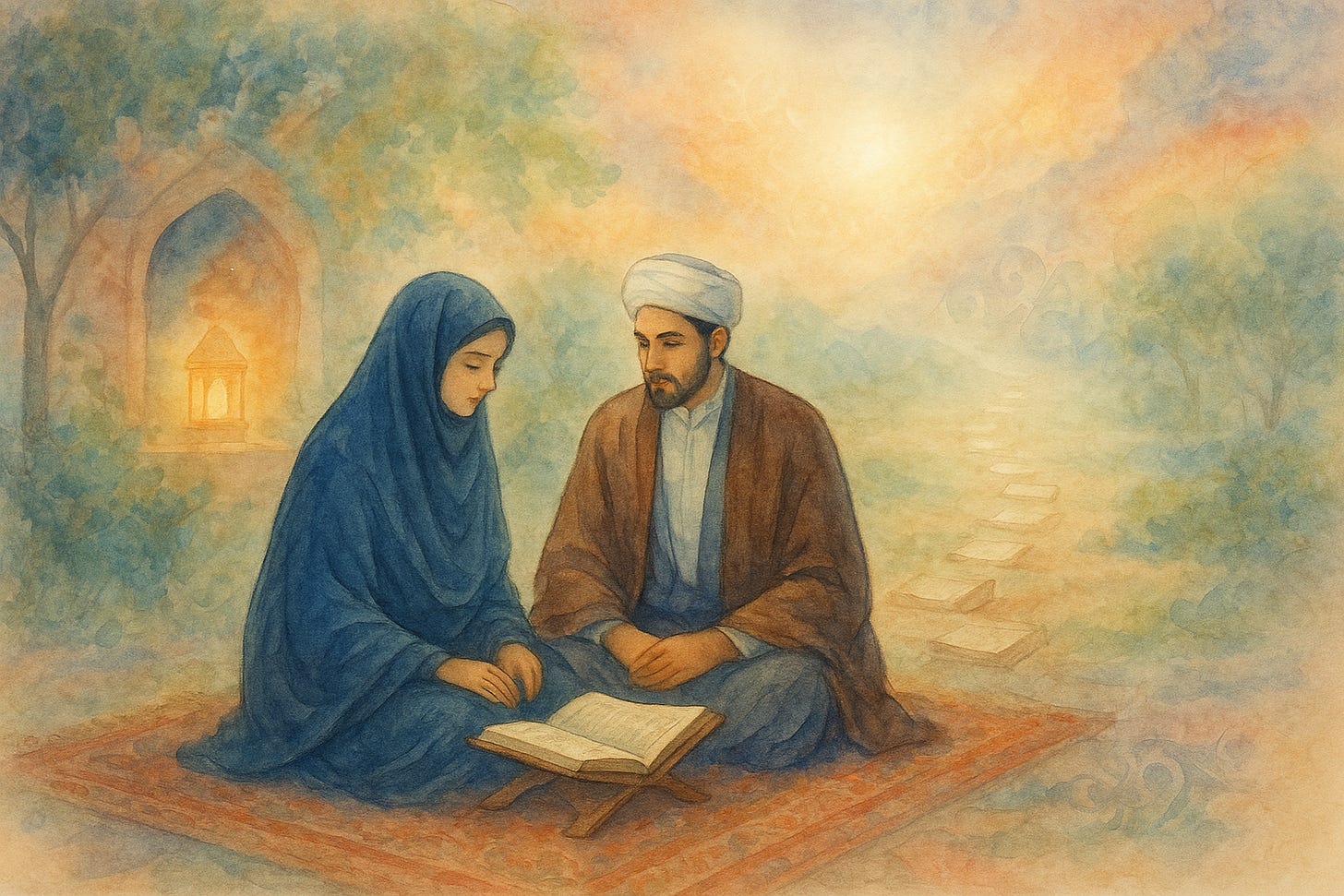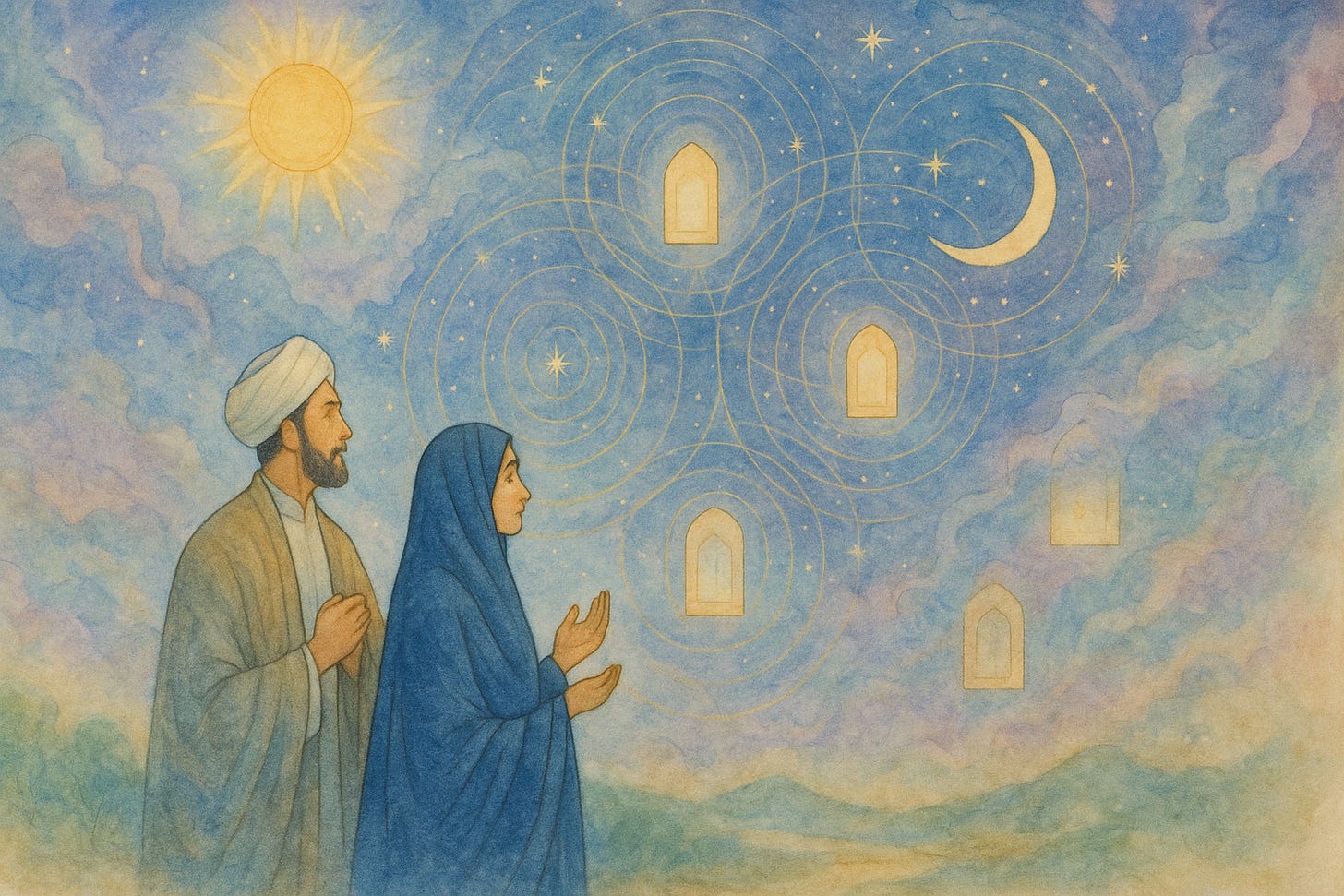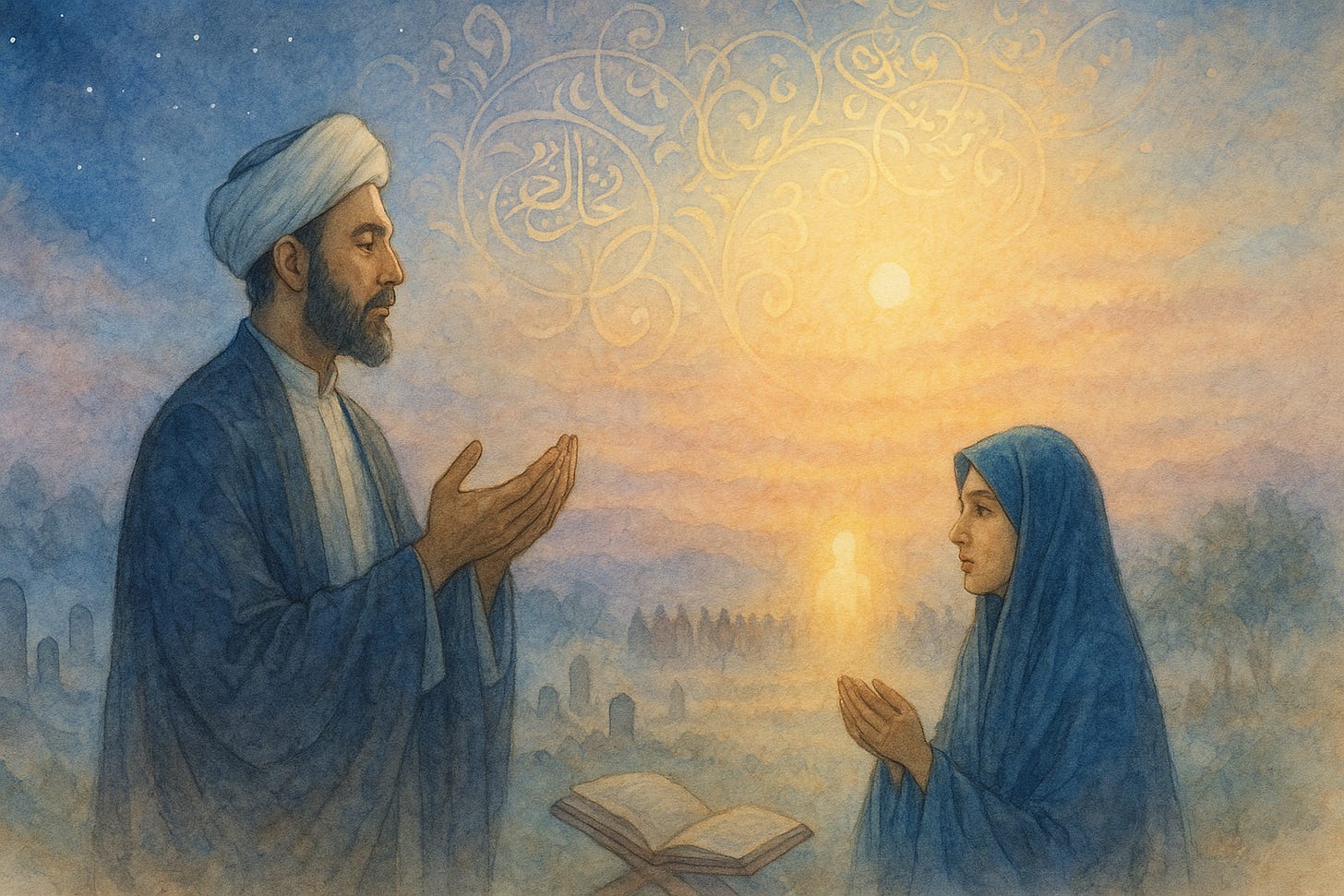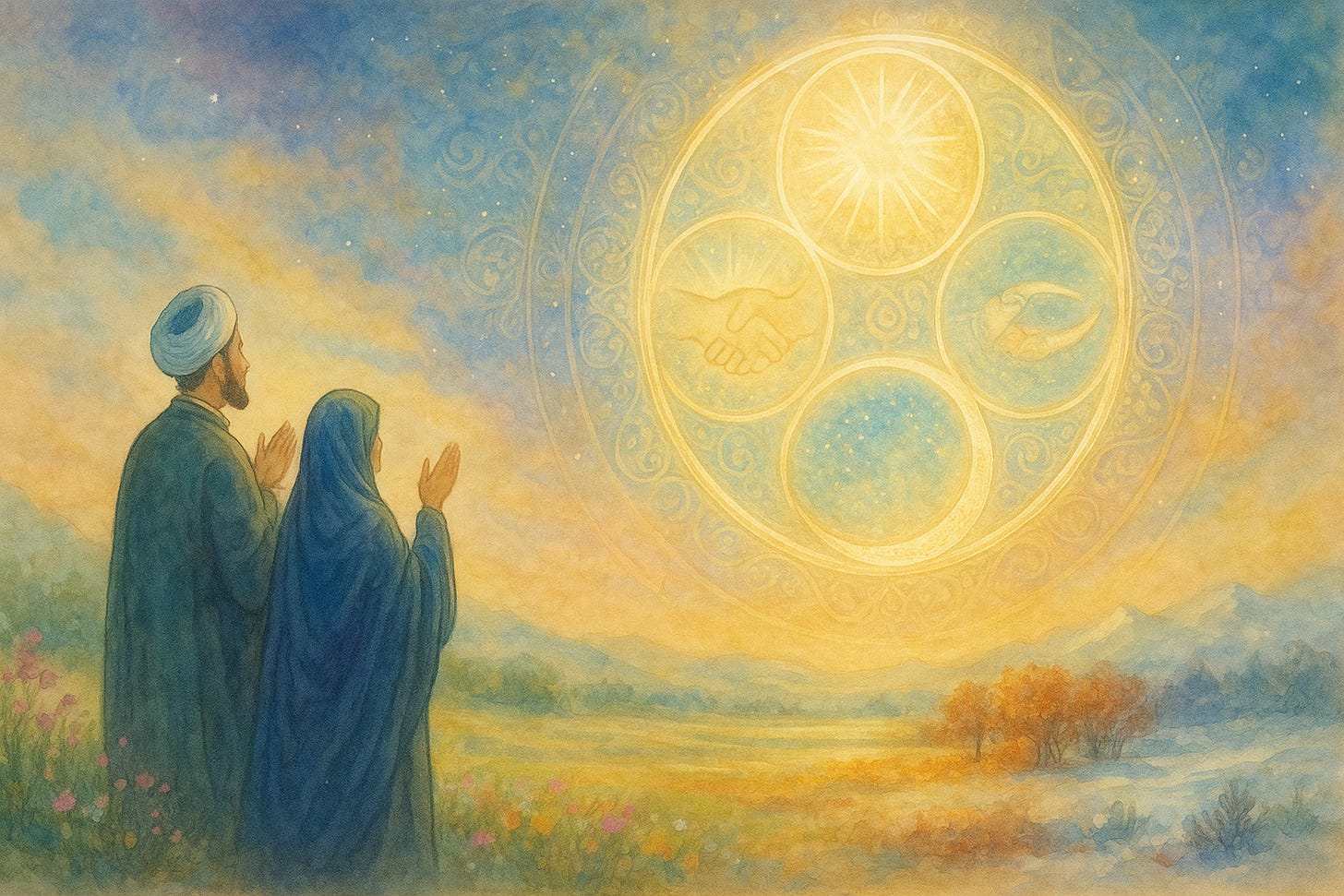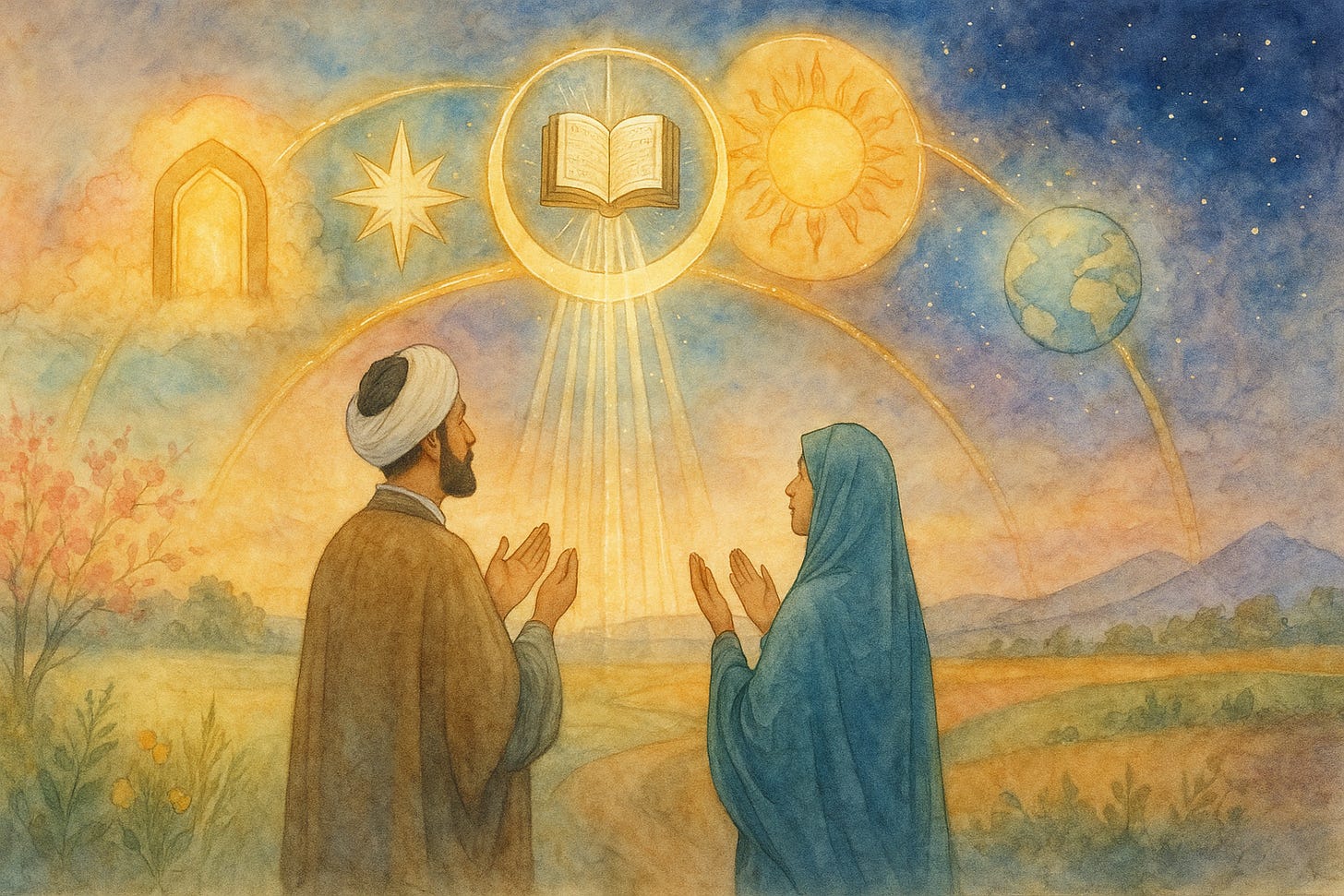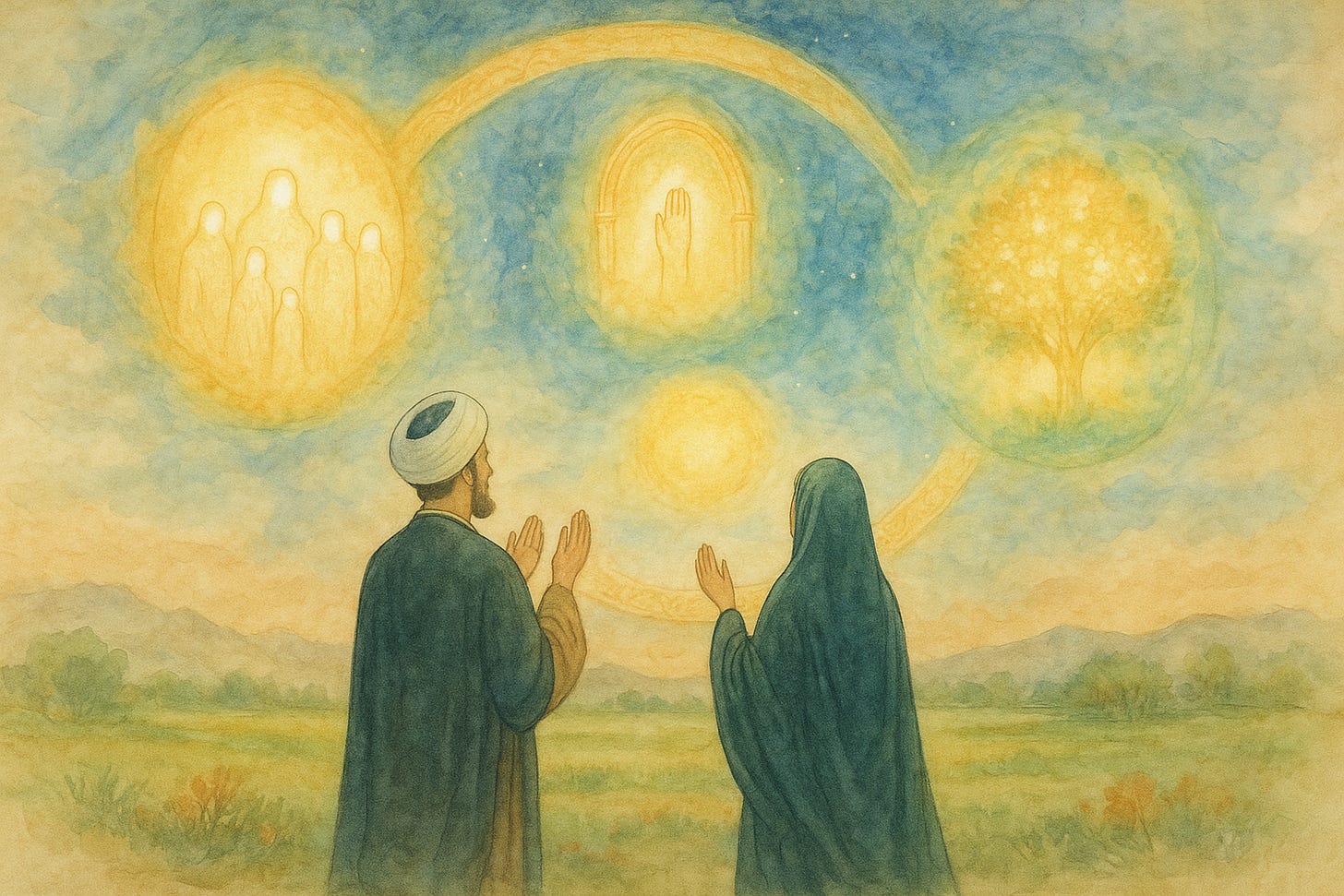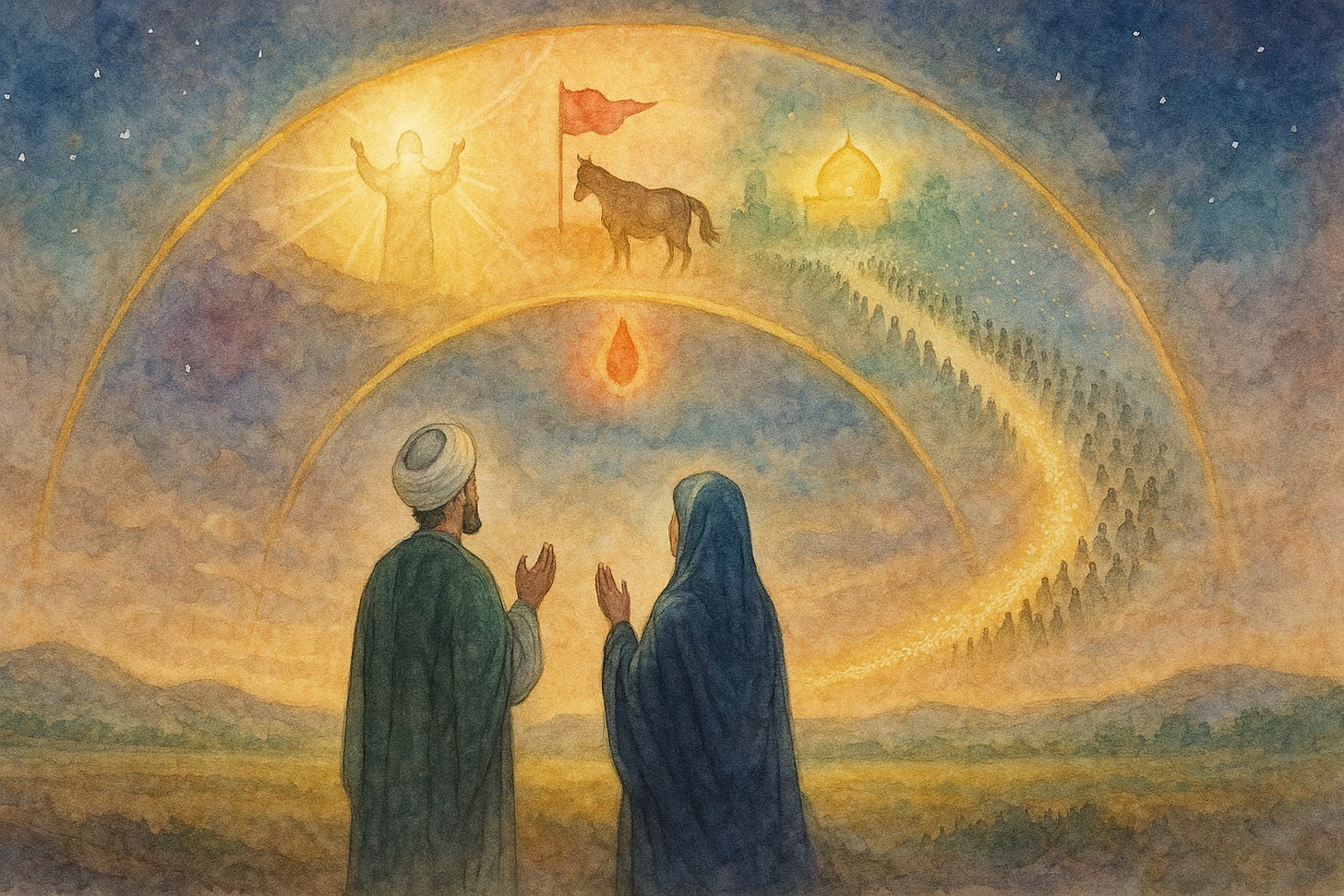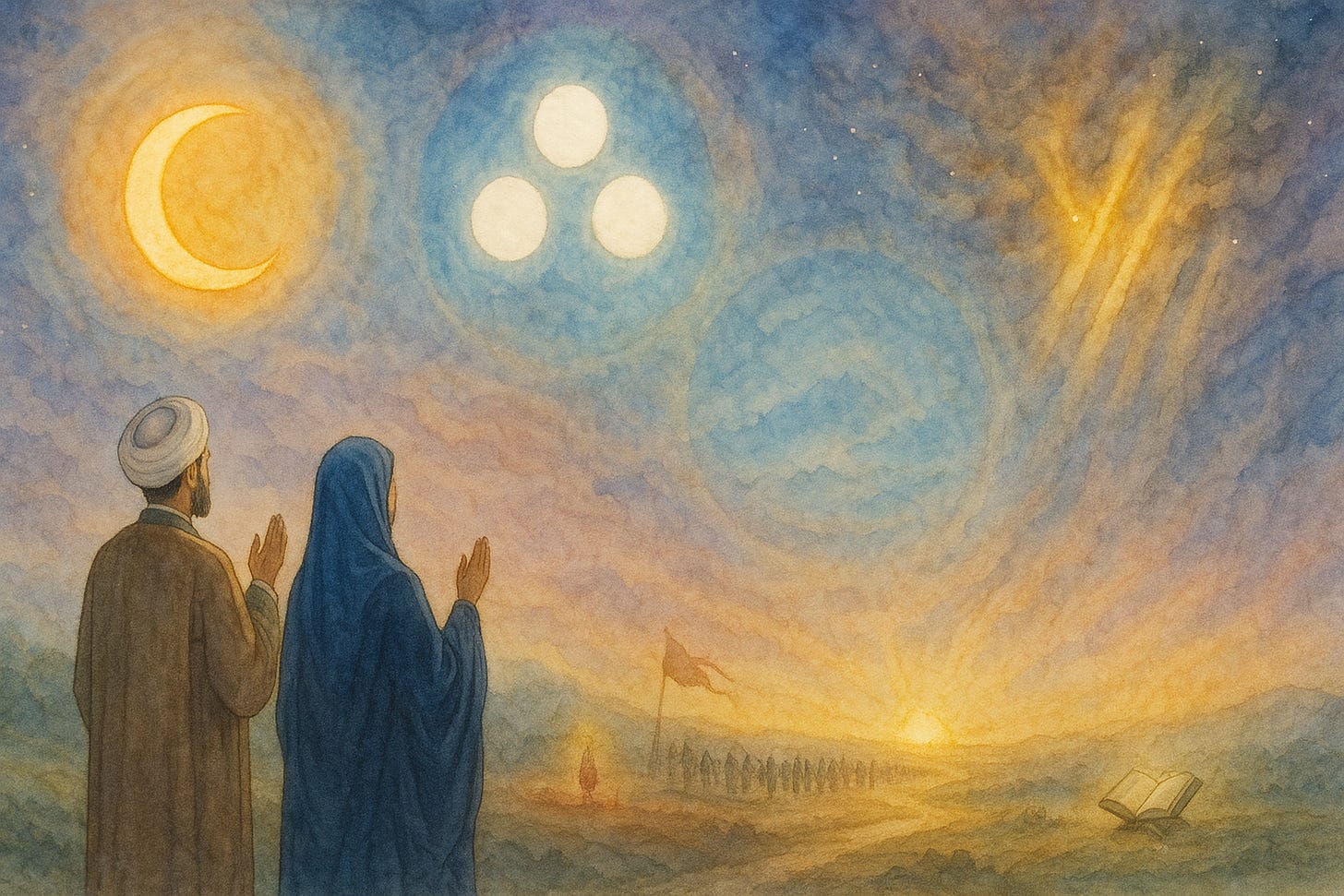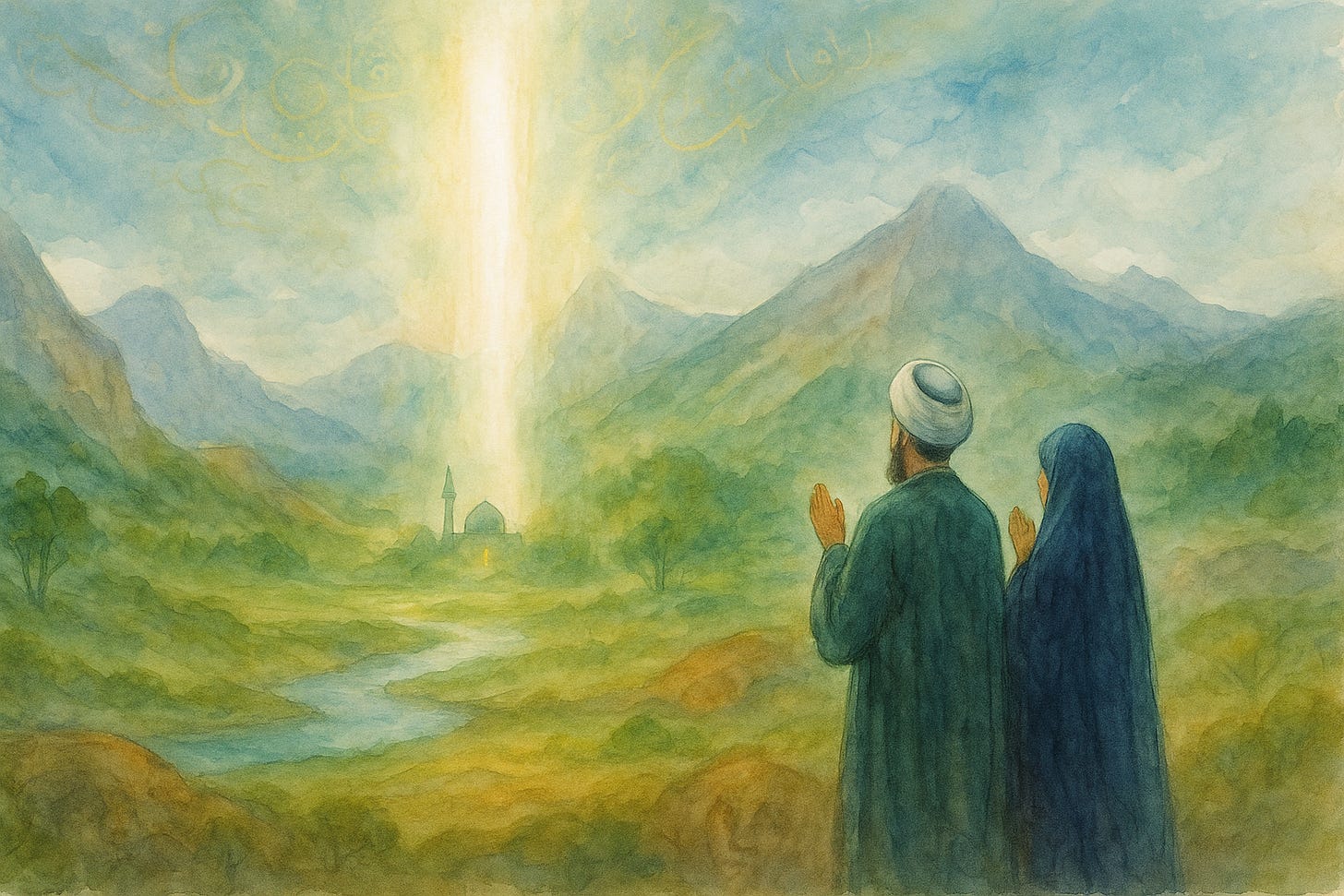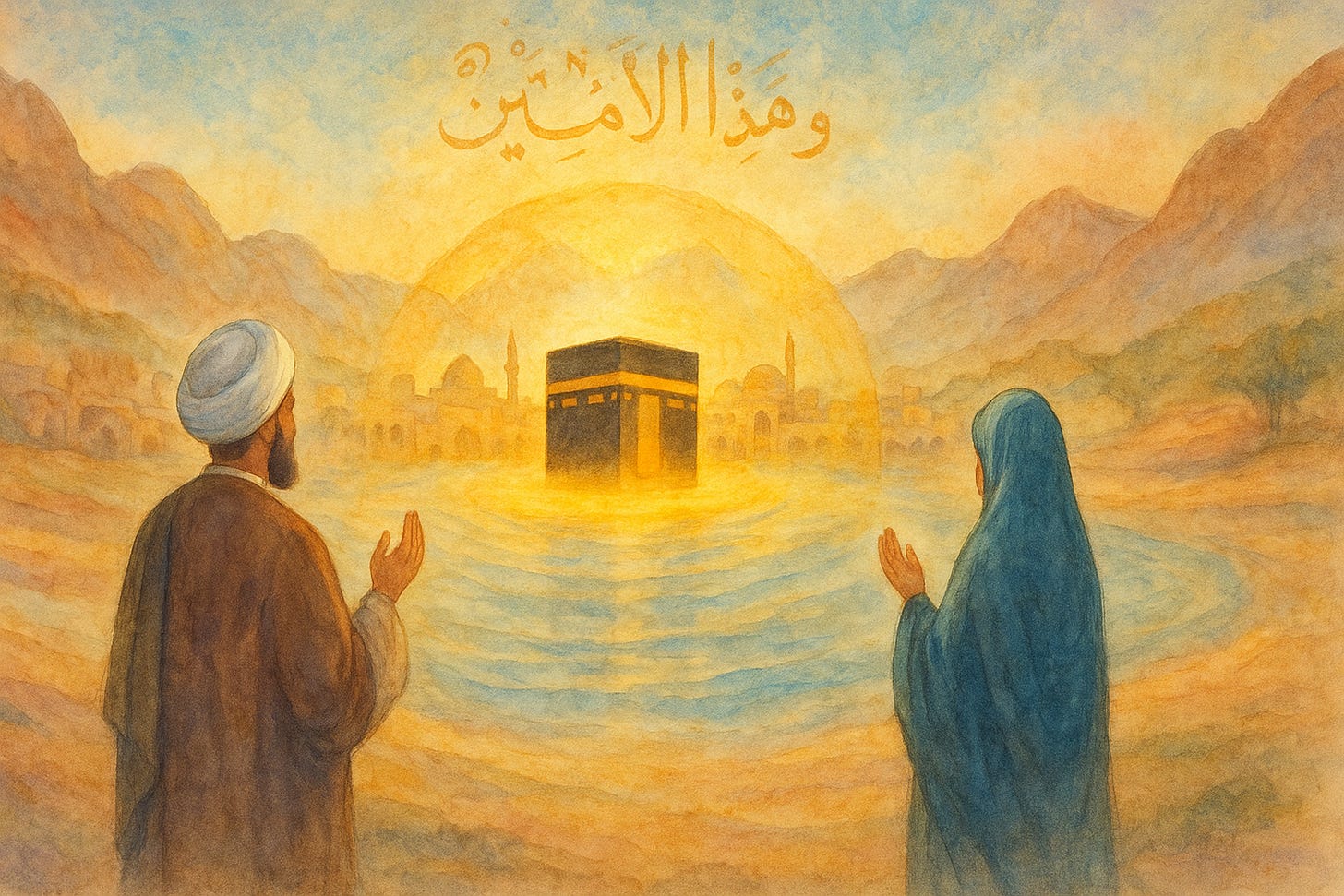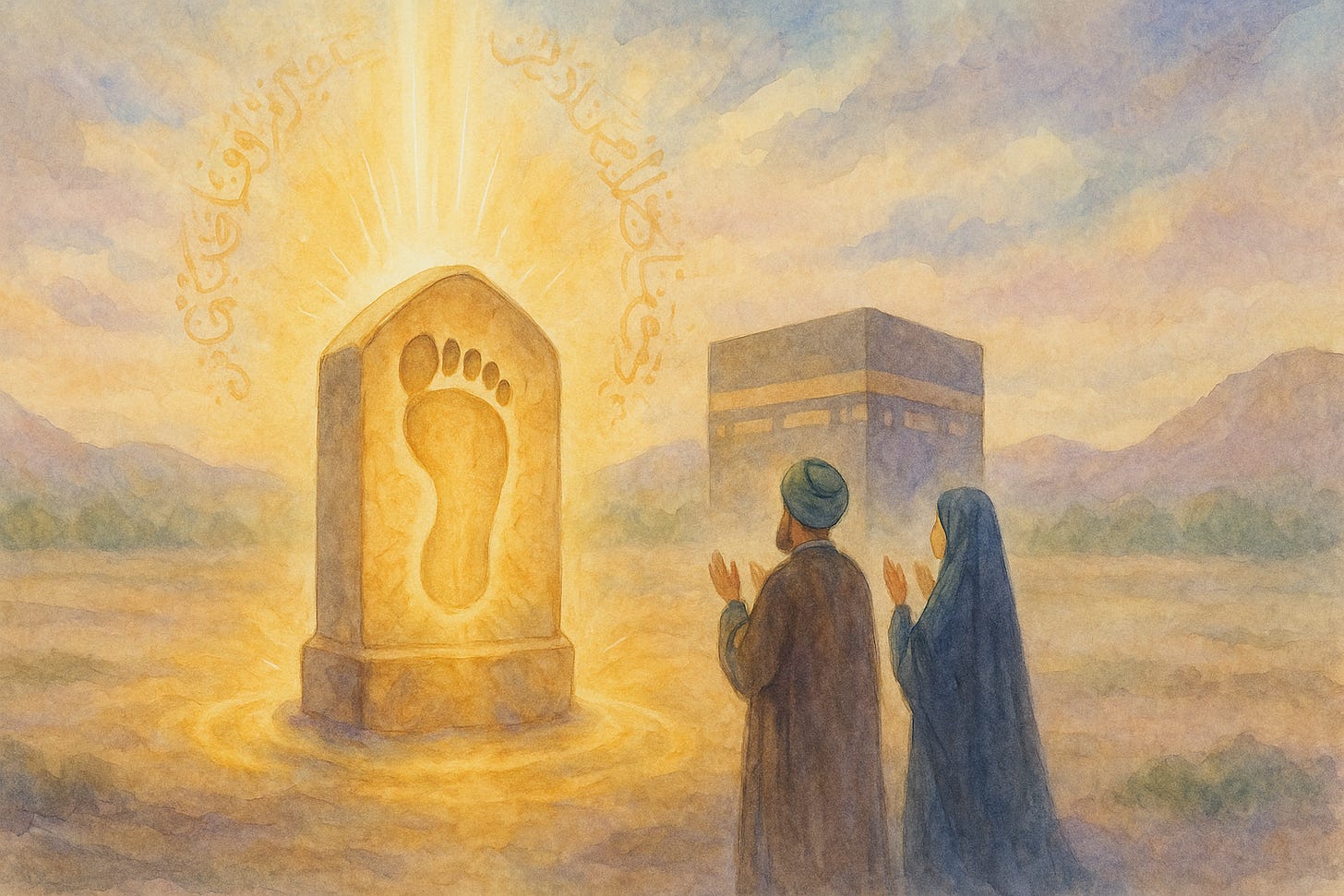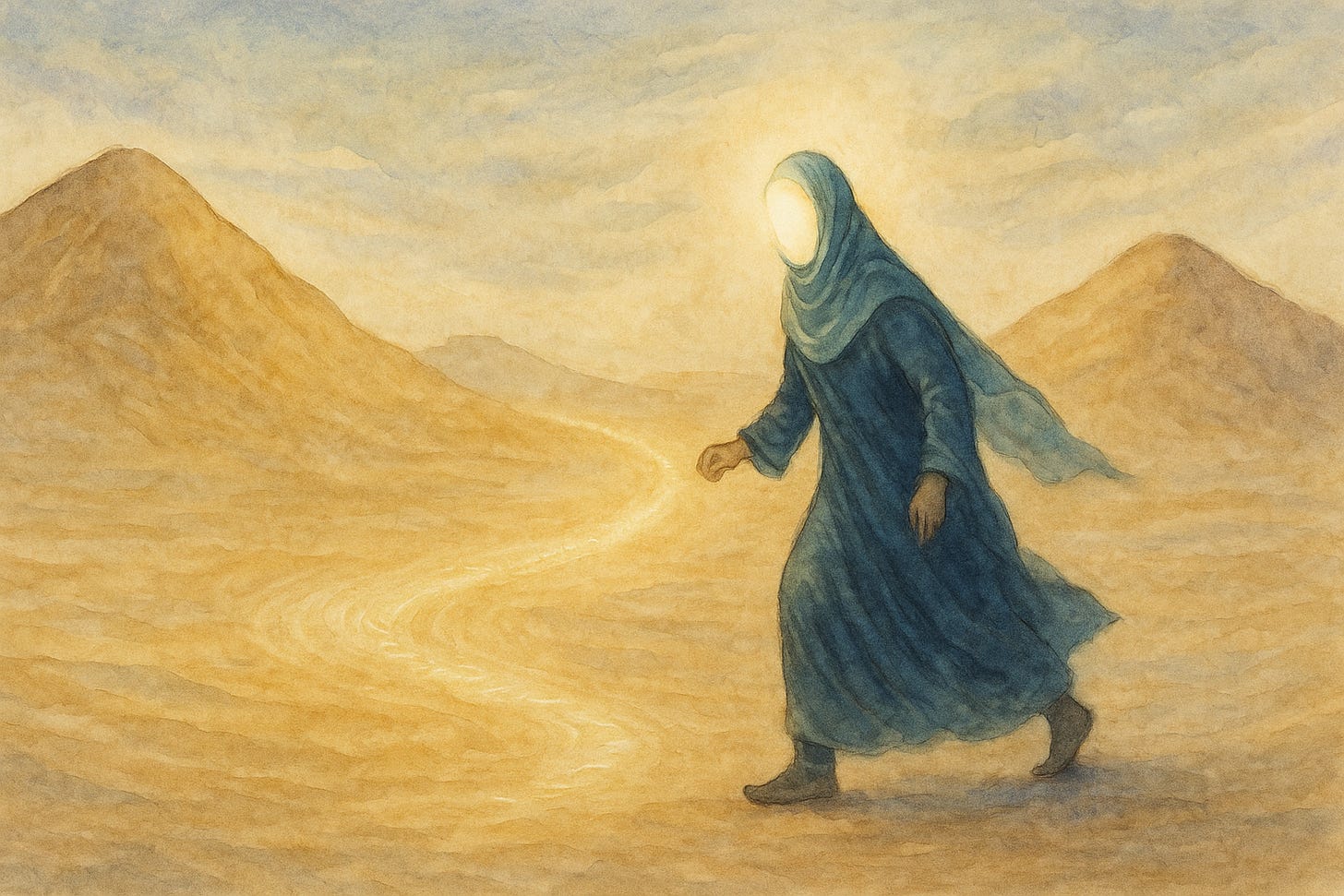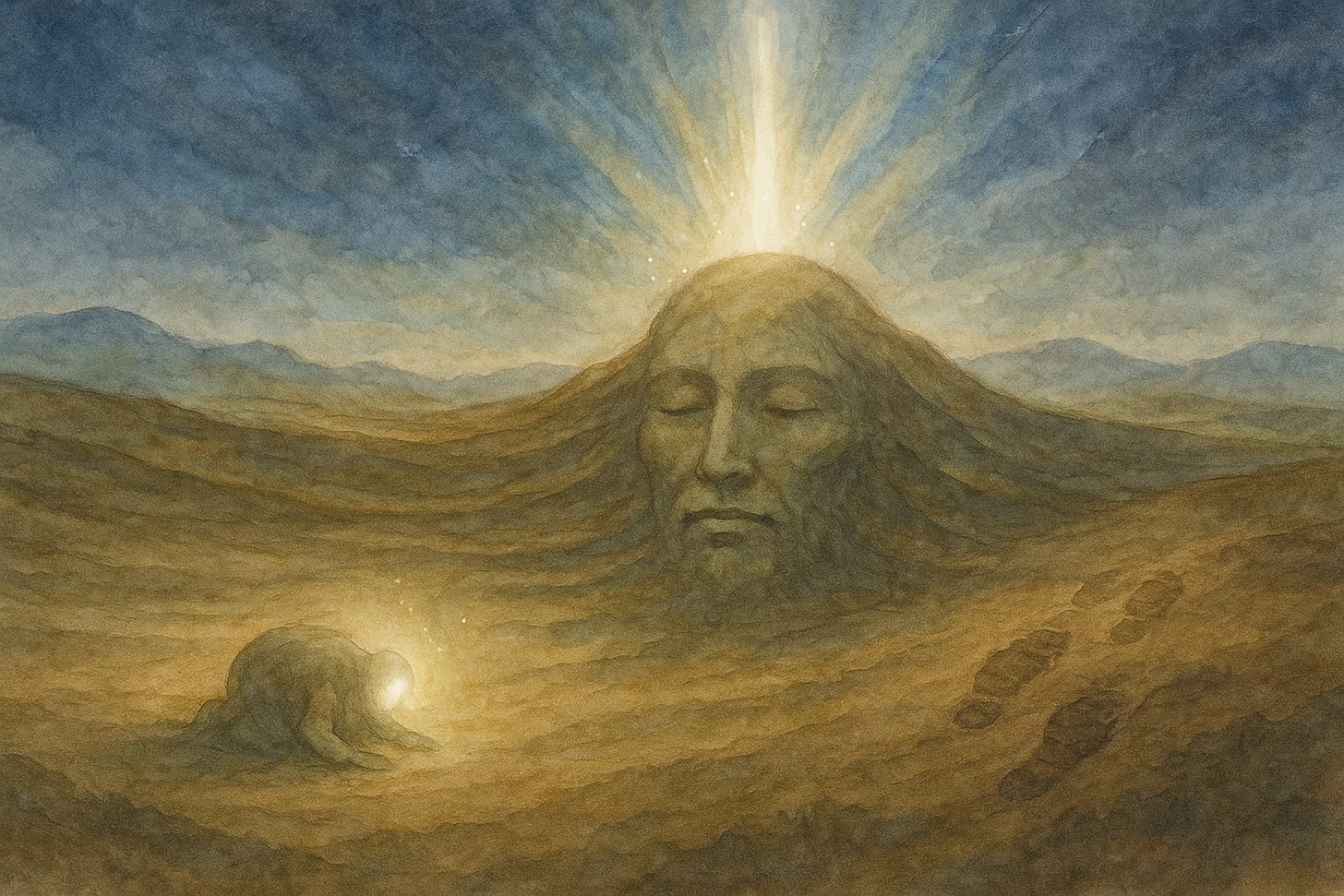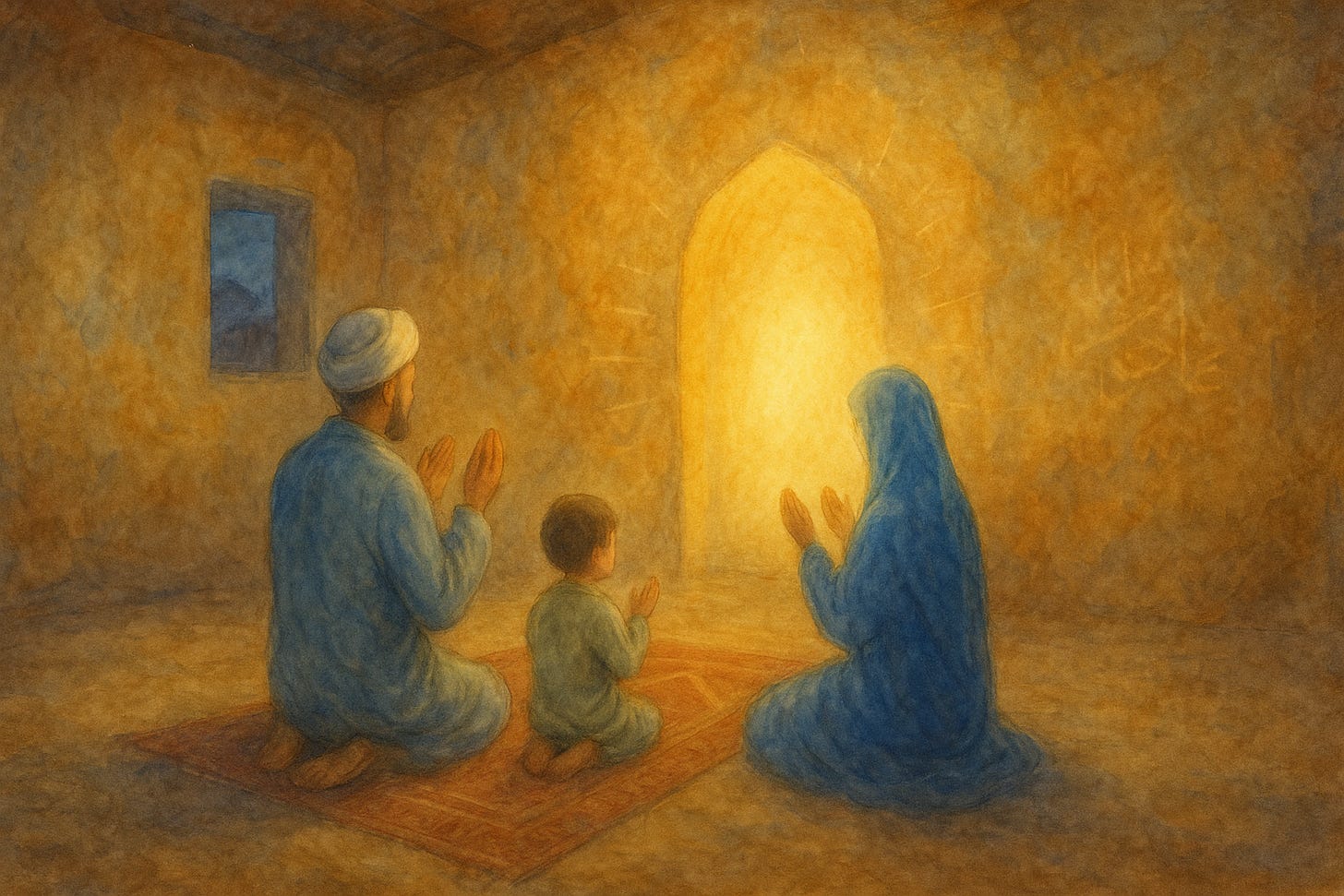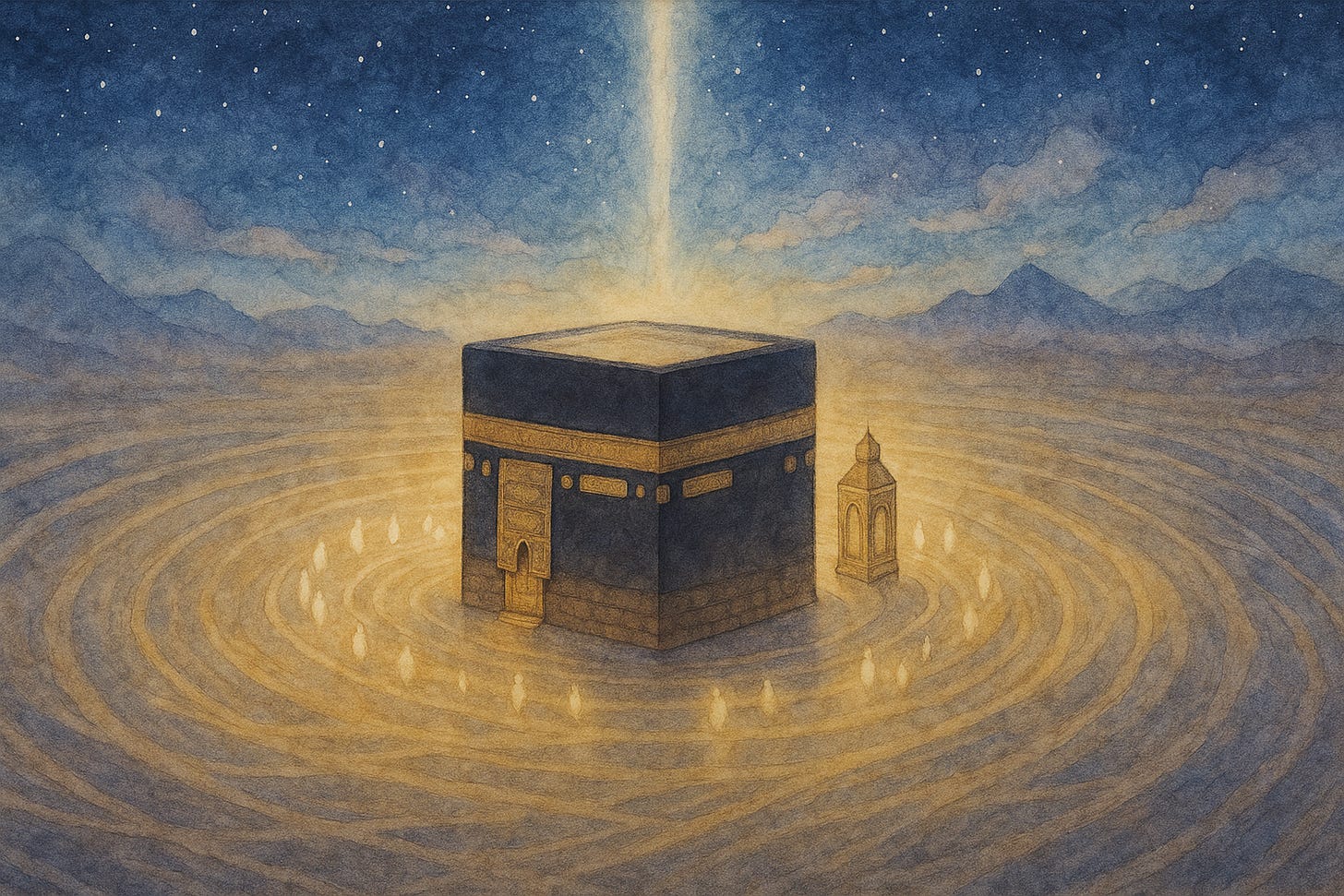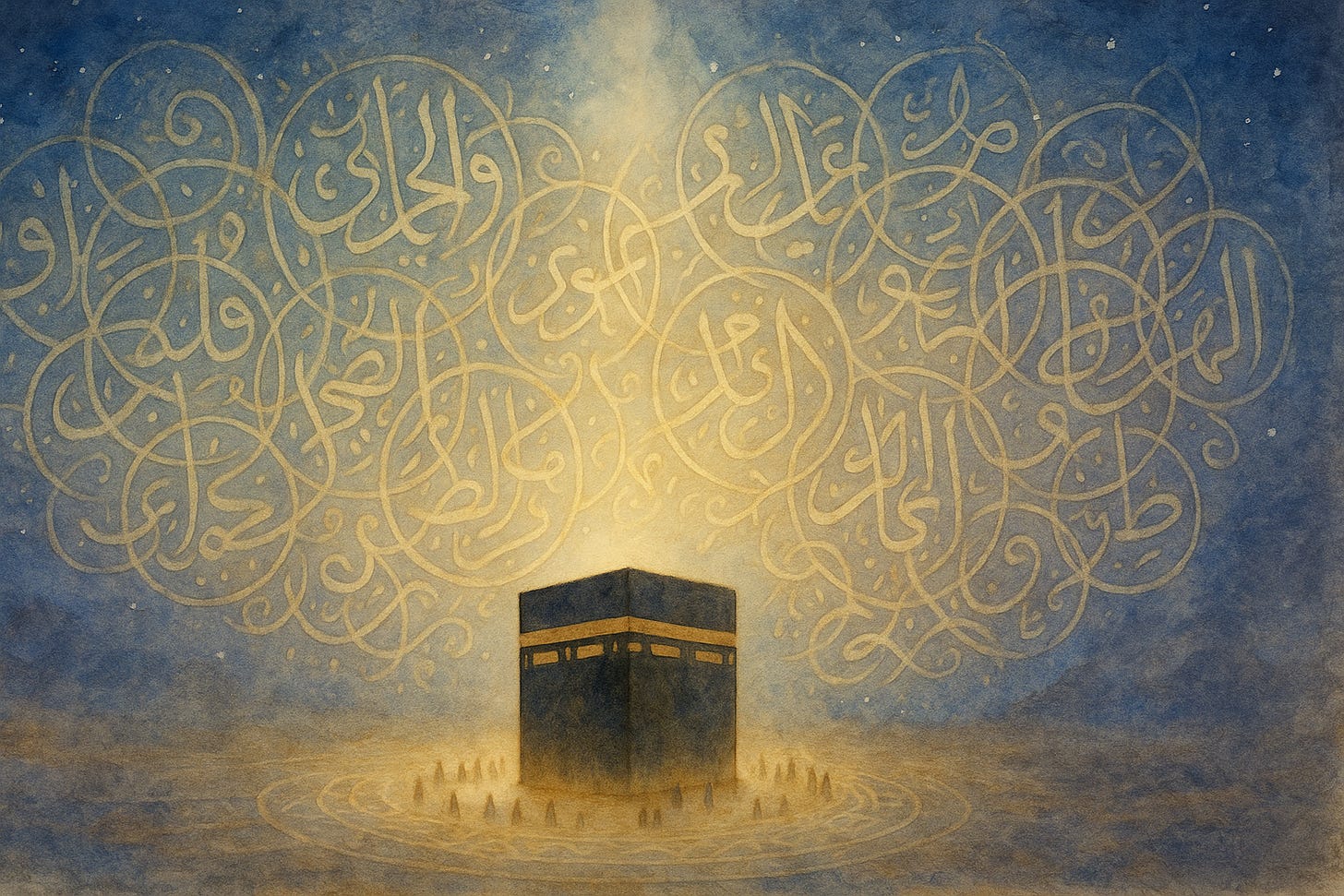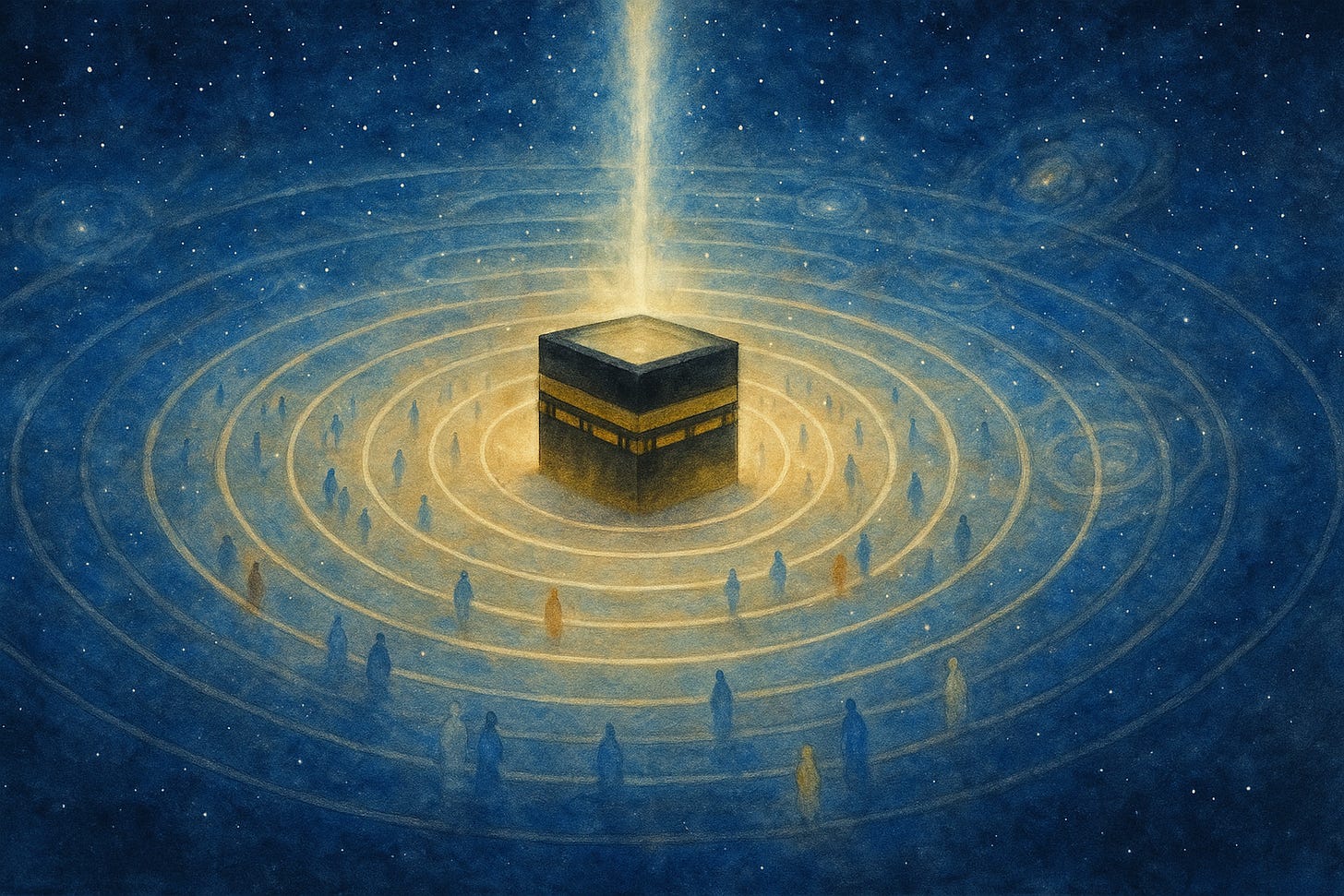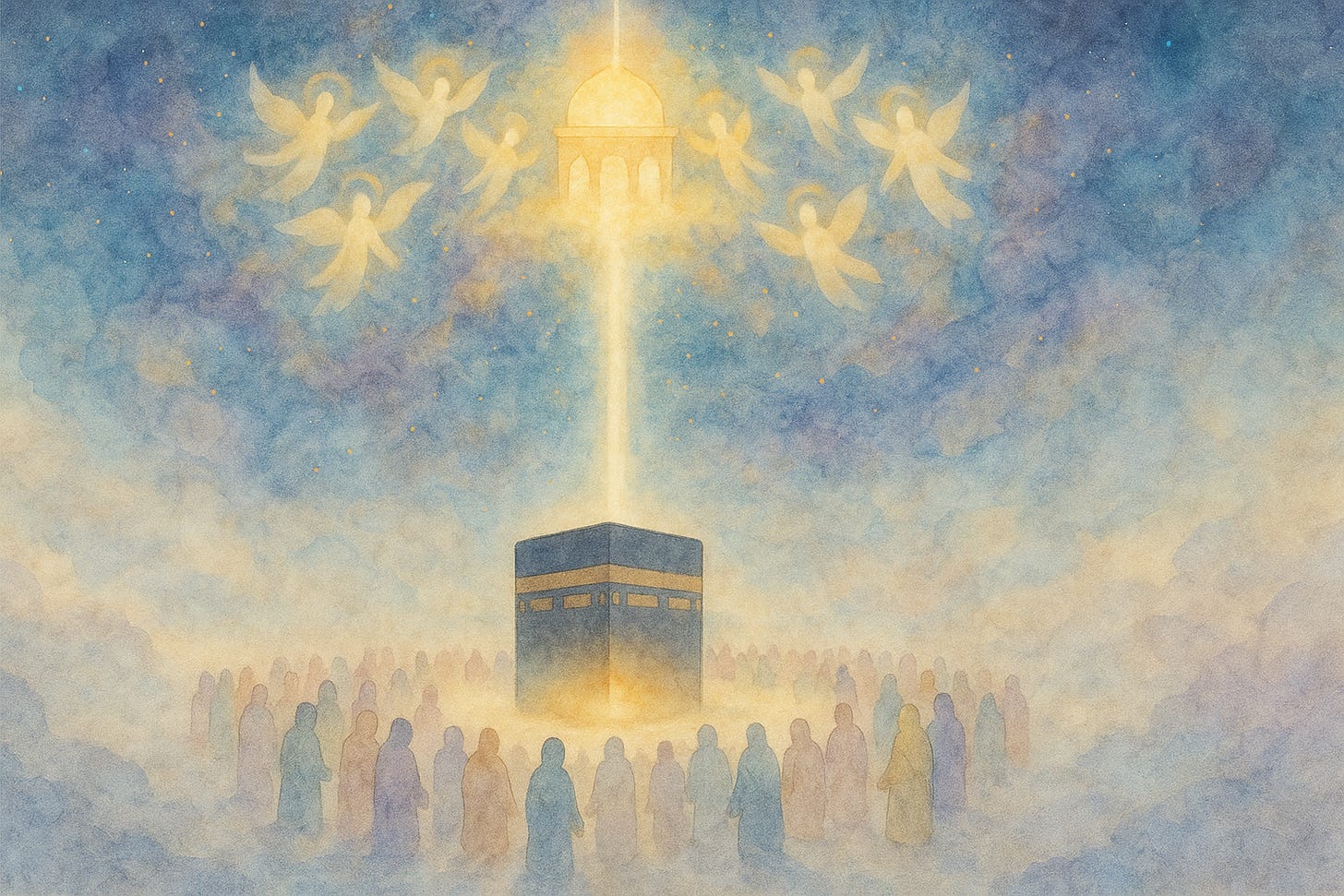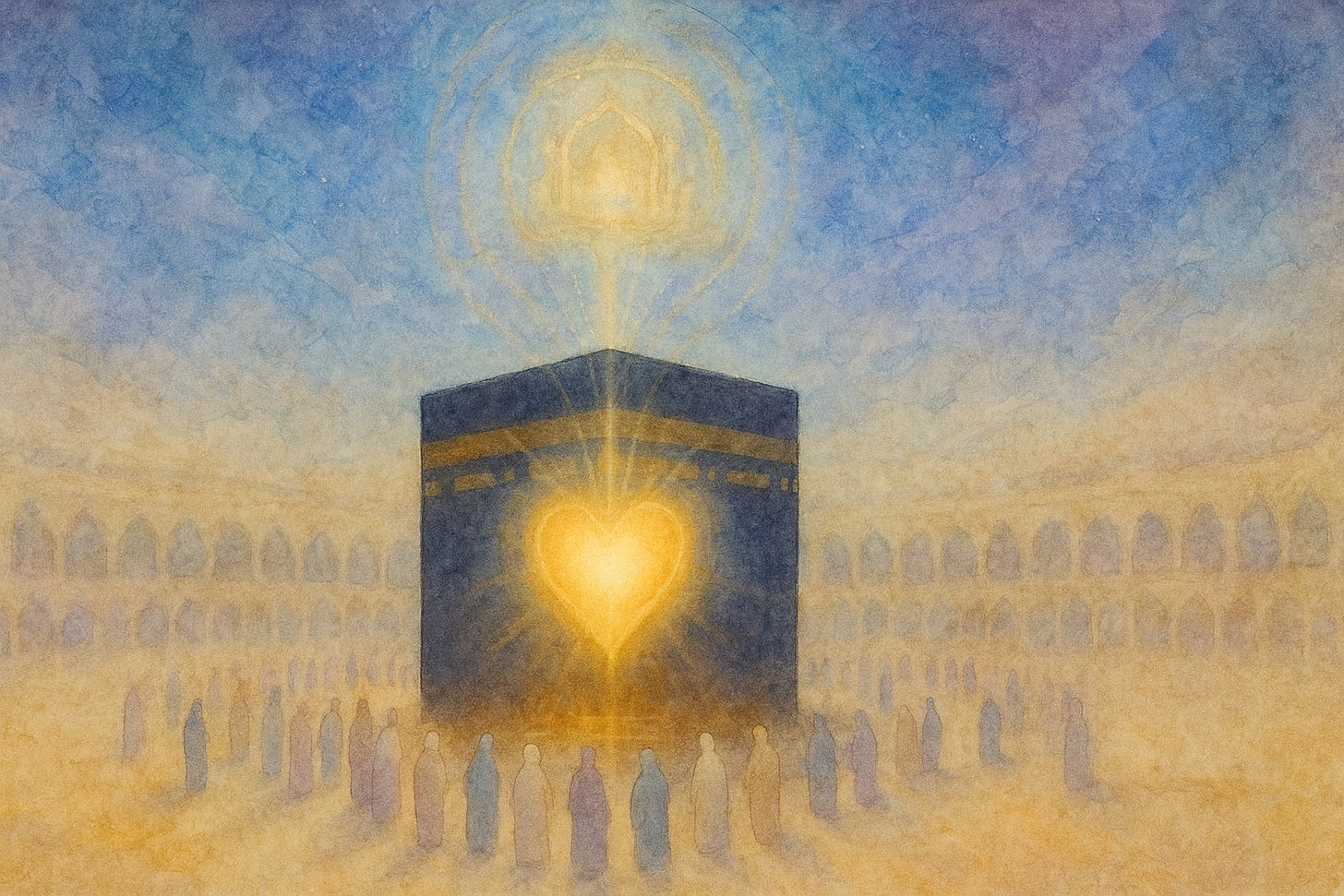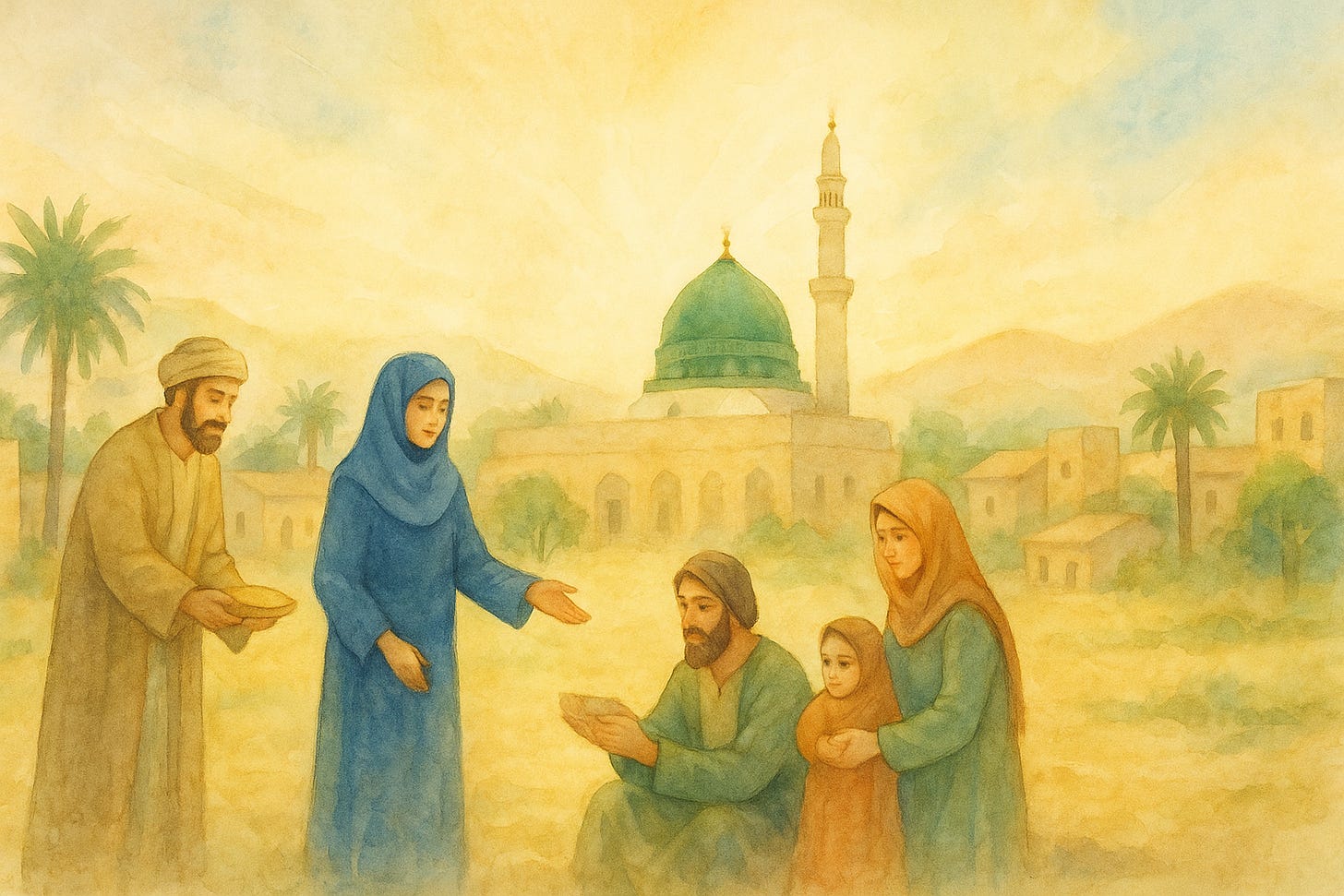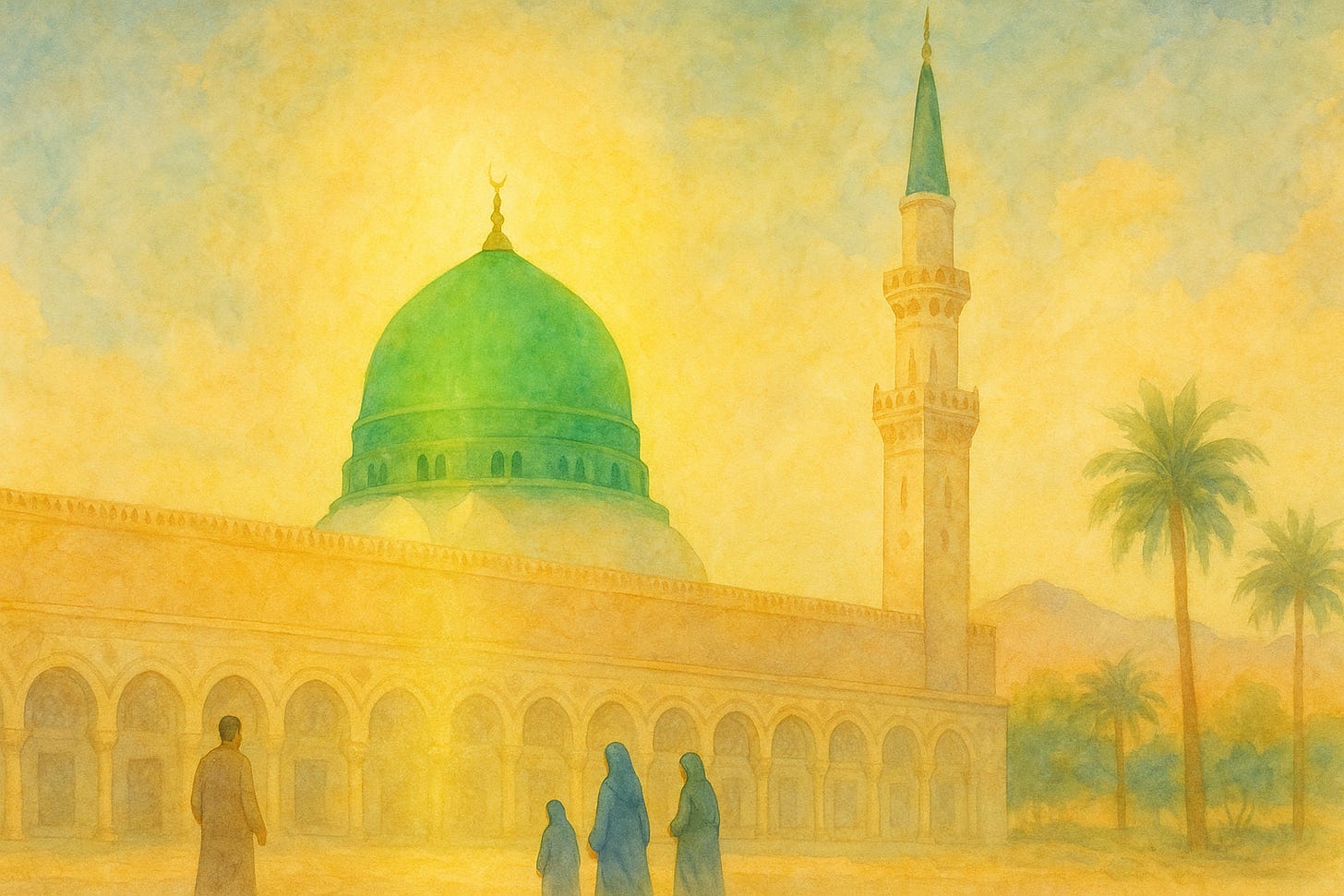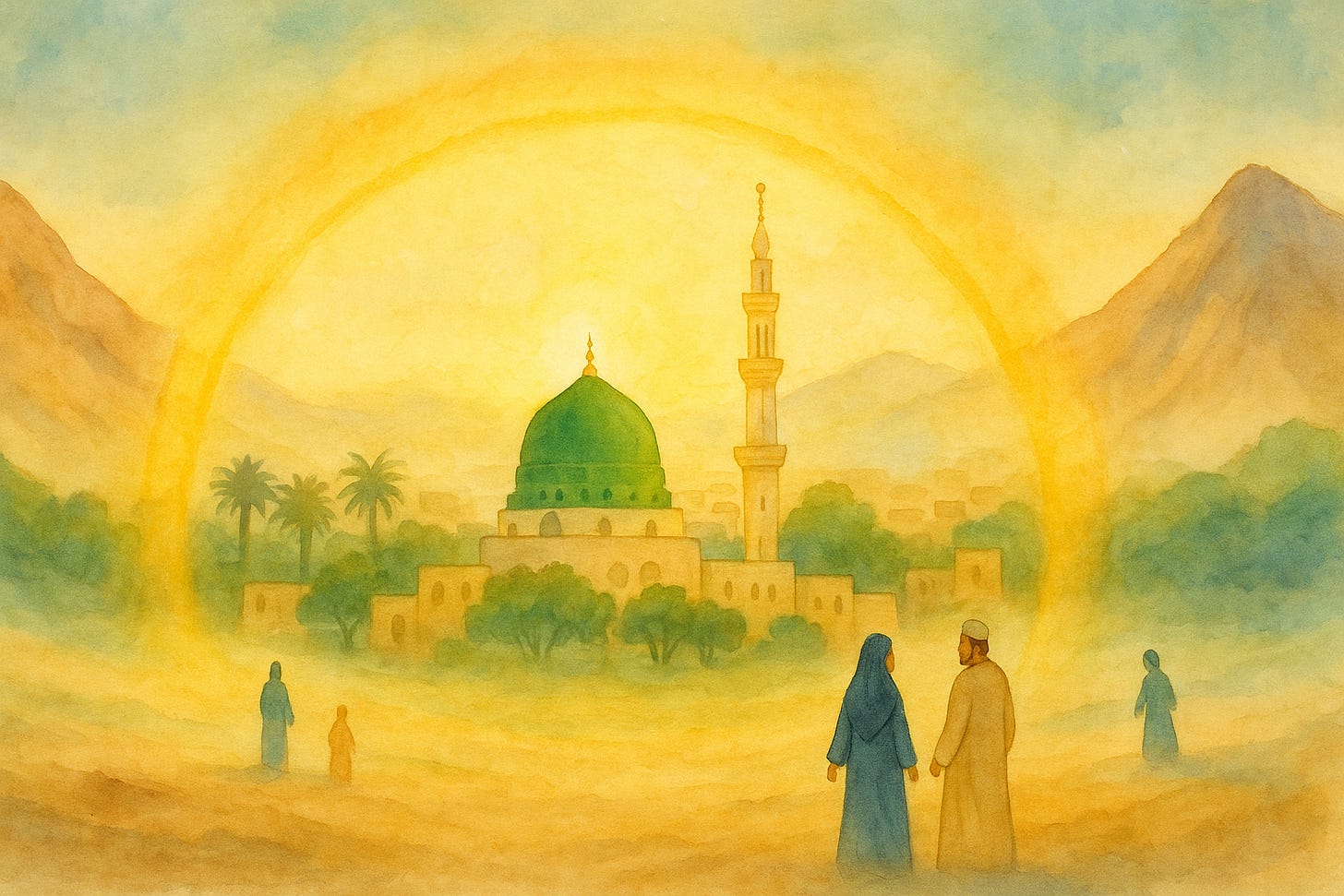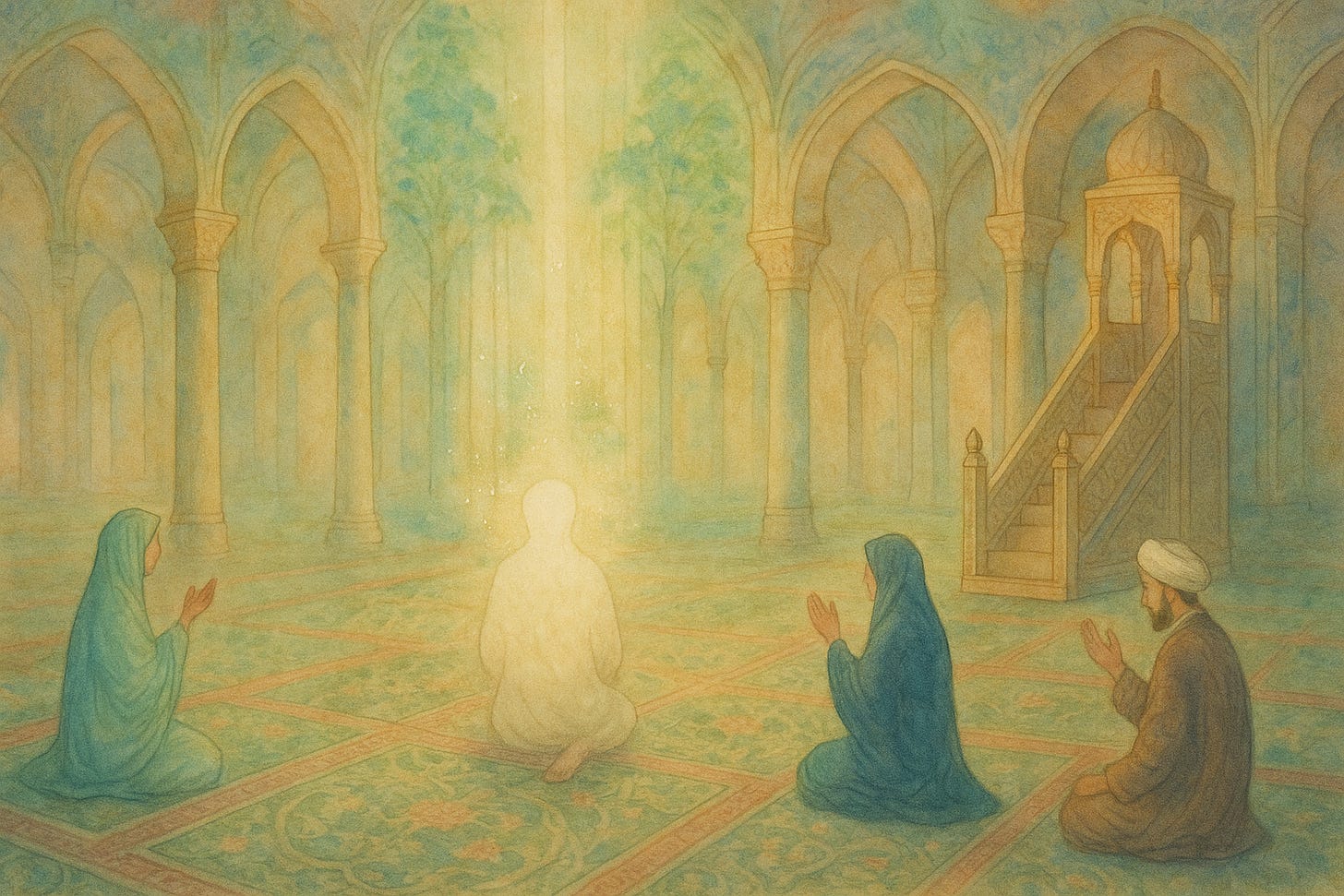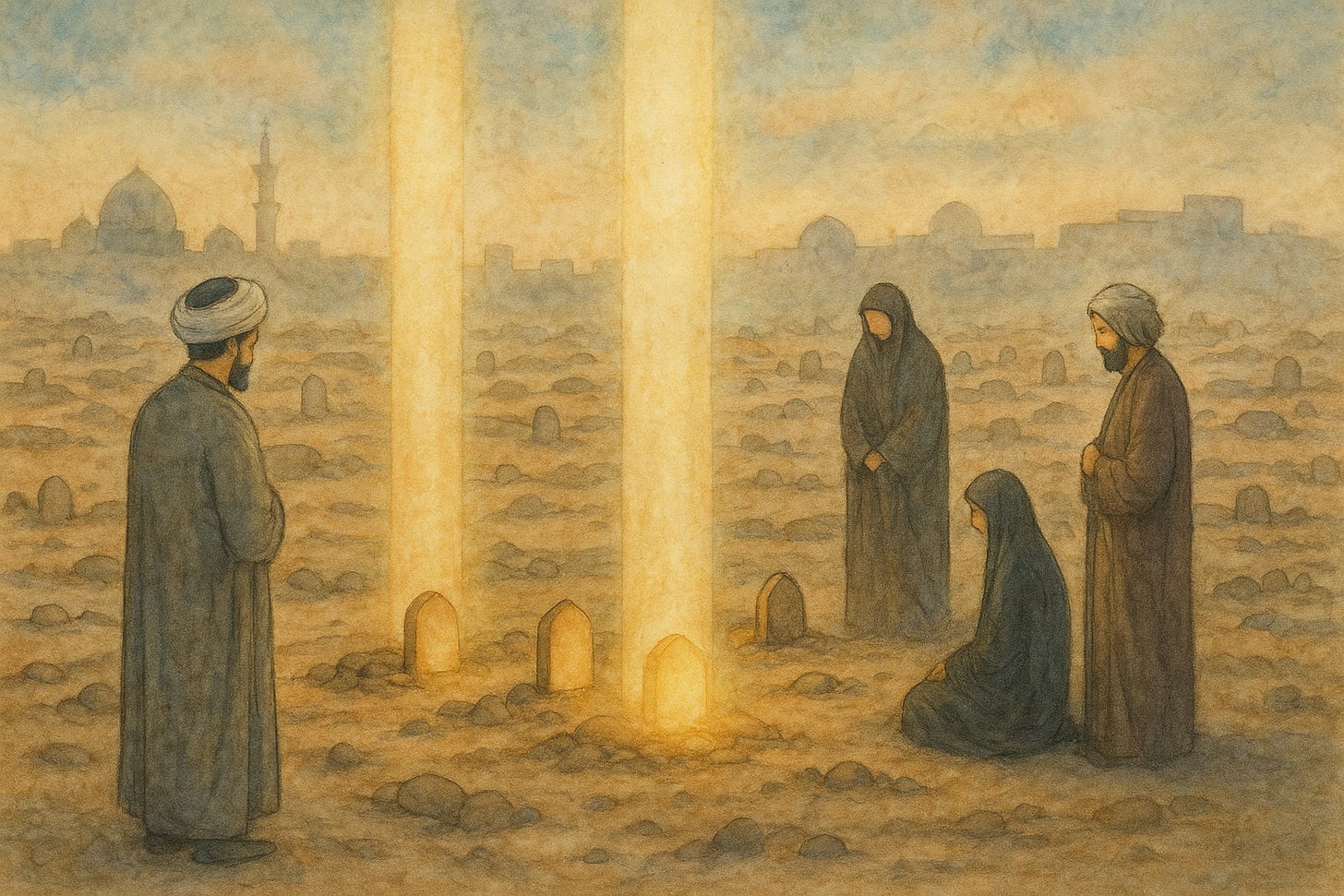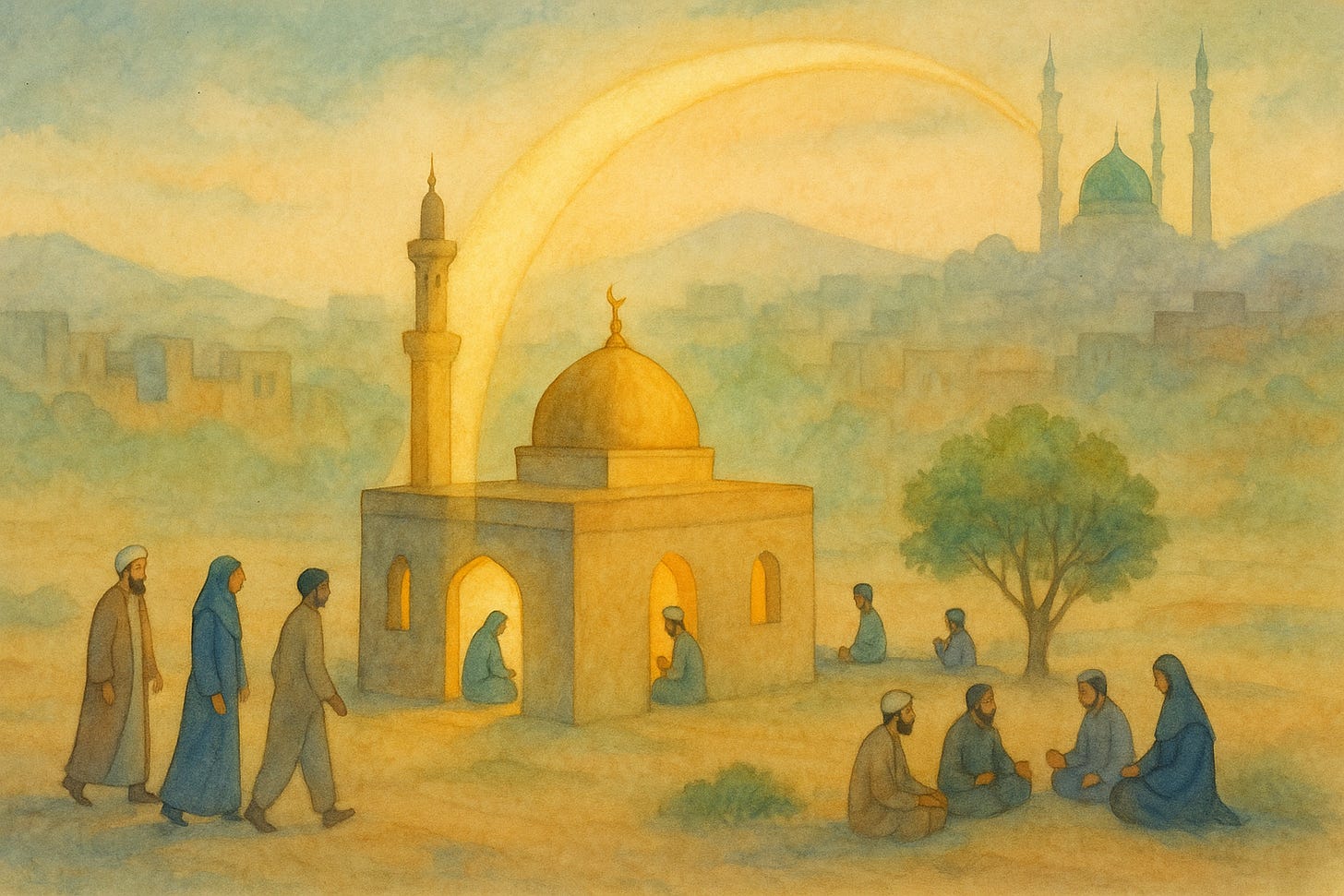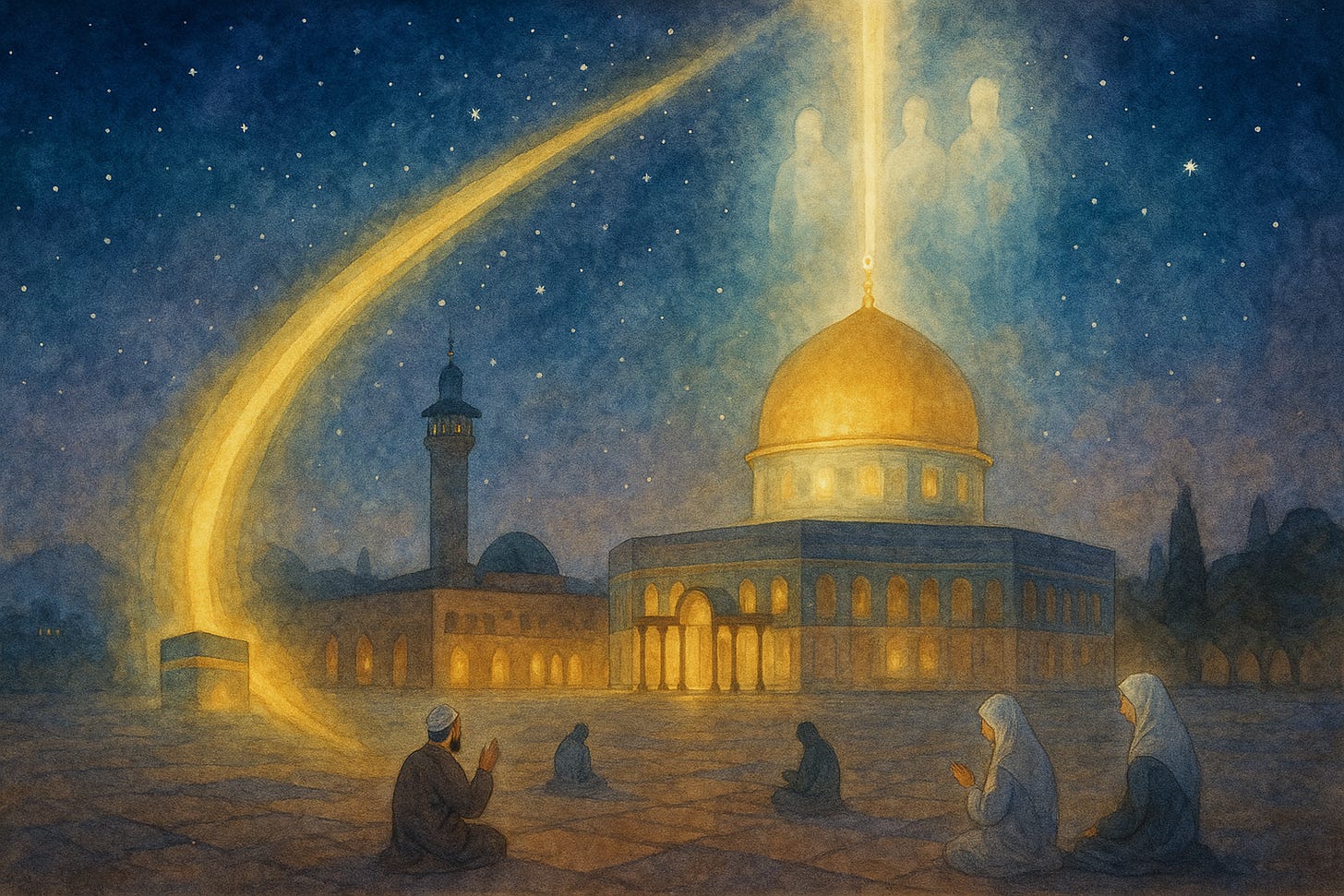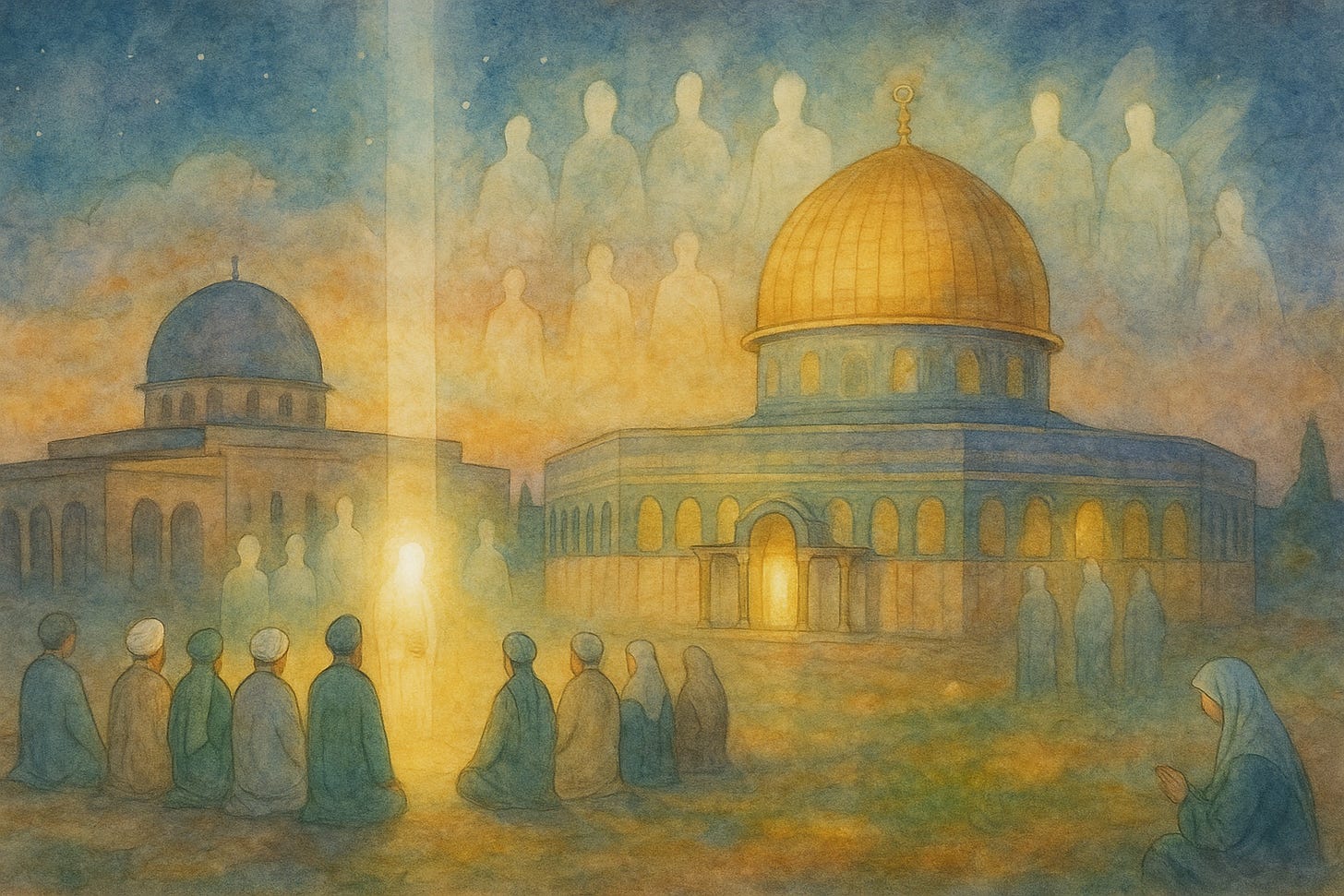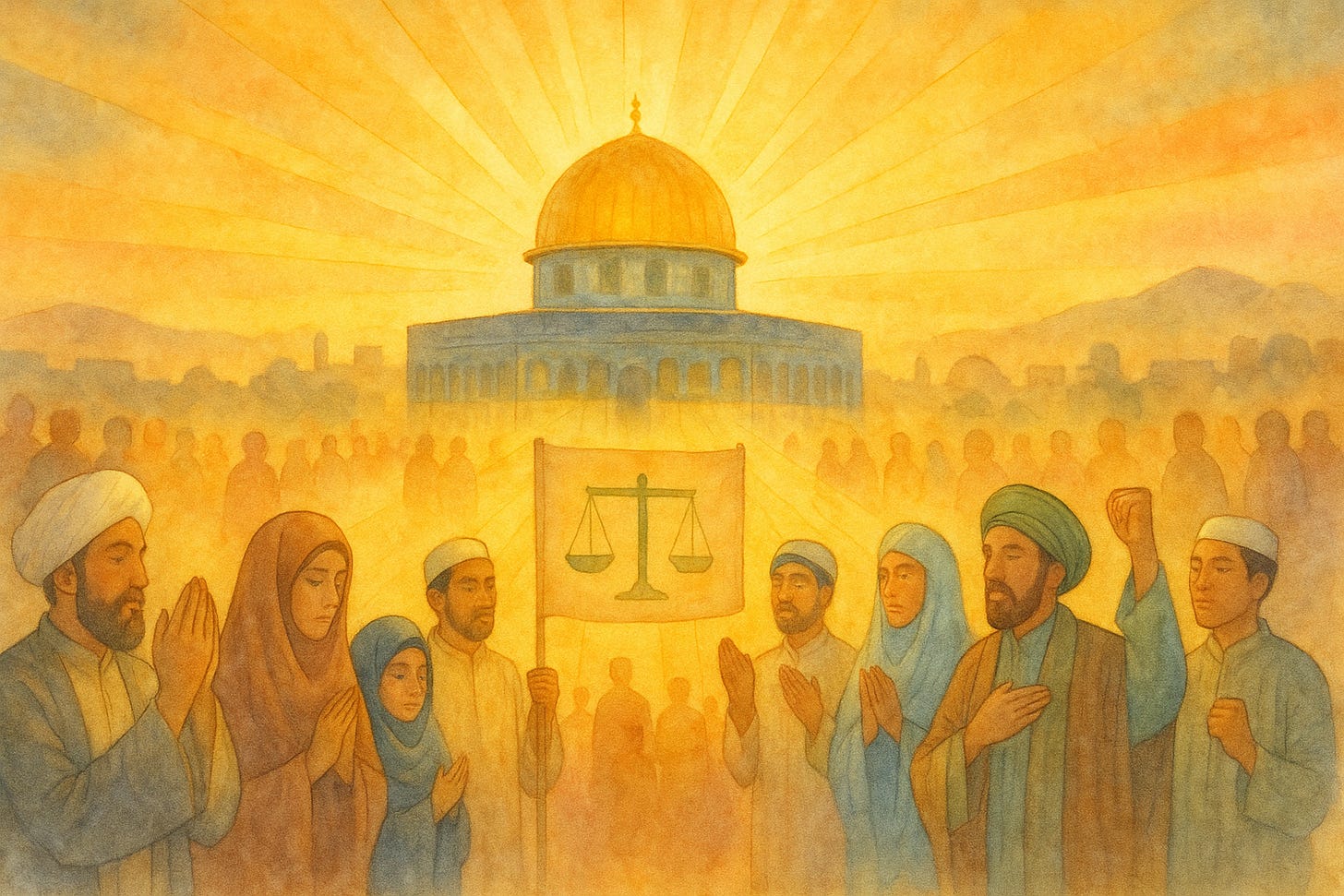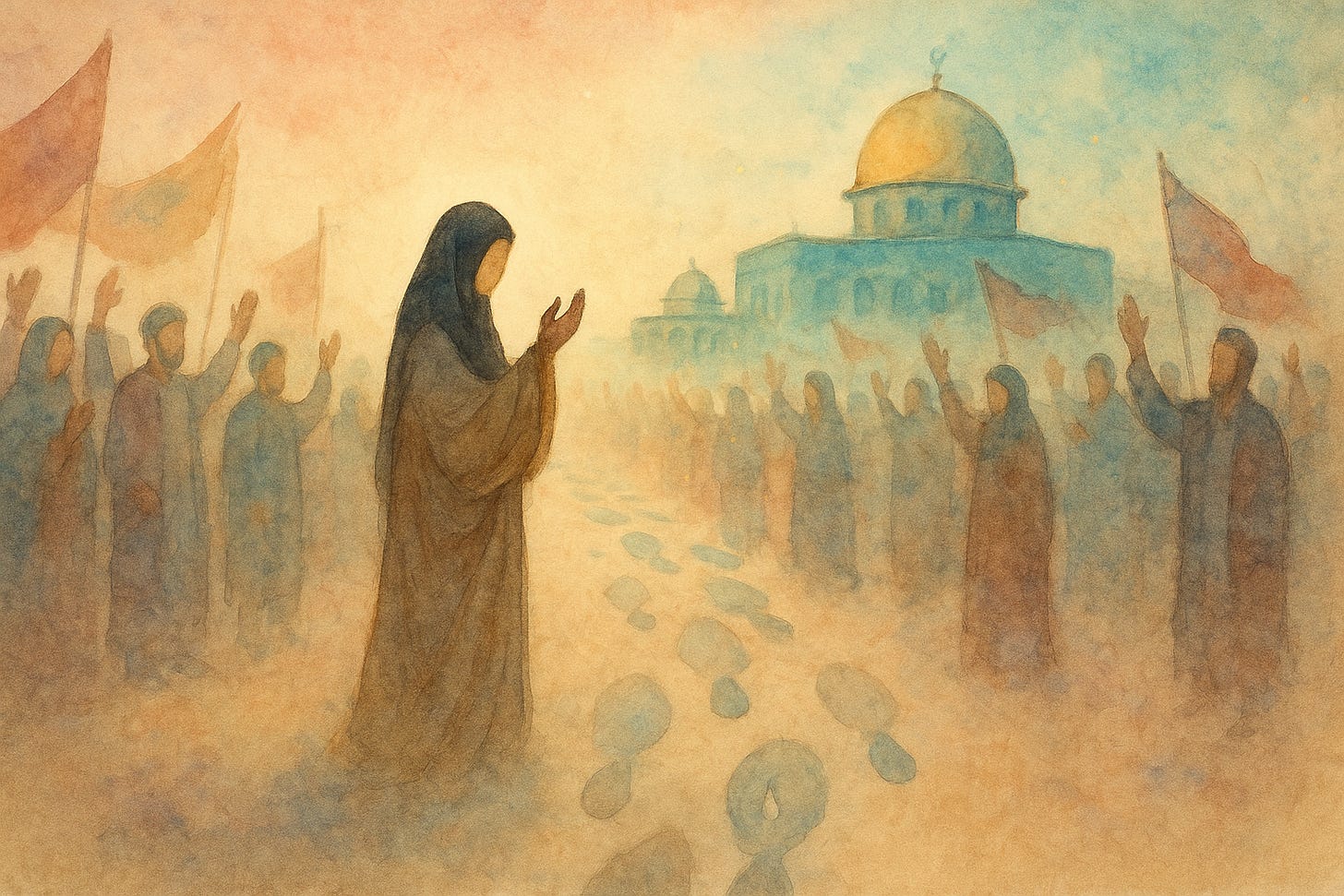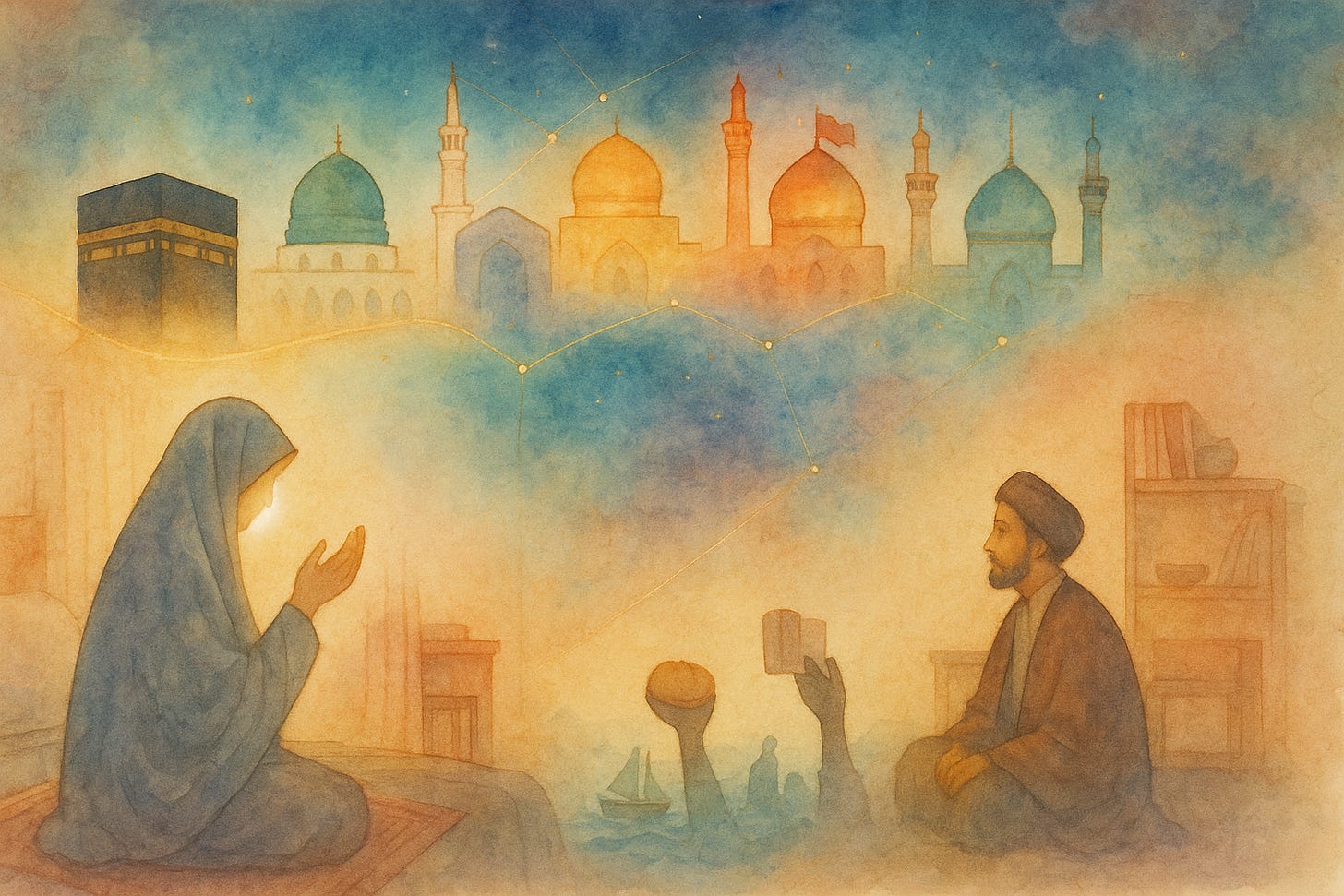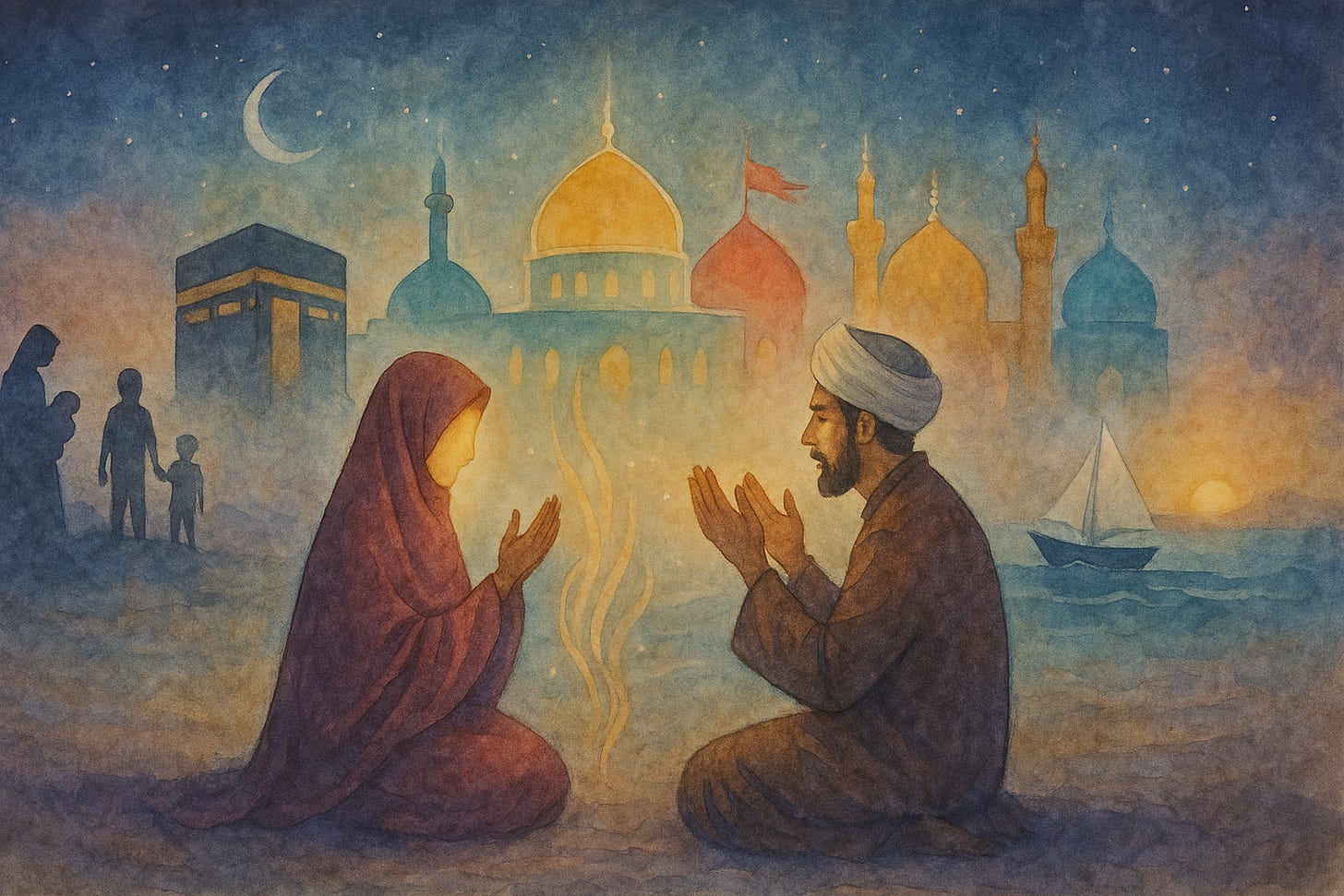[16] The Art of Supplication - The Sacred Windows: The Role of Place - Part 1 - Where Earth Meets Heaven
A series of discussions based on the book Uddat al-Dai wa Najah as-Saee - The Provision of the Supplicant, and the Triumph of the Seeker by Ibn Fahd al-Hilli on the subject of Supplication and Prayer.
In His Name, the Most High
This is the sixteenth part of our series, The Art of Supplication, an ongoing exploration into the sacred relationship between the supplicant, the supplication, and the Divine.
The insights within this series are cumulative, and the nature of our discussion requires that each part build upon foundations laid in the ones that came before.
To prevent any misunderstanding and to fully benefit from the depth of this subject, it is essential that you engage with the previous parts in order before continuing with this one.
The previous parts in this series can be found here:
Video of the Majlis (Sermon/Lecture)
This write up is a companion to the video majlis (sermon/lecture) found below:
Audio of the Majlis (Sermon/Lecture)
This write up is a companion to the audio majlis (sermon/lecture) found below:
Recap
The Sacred Windows: The Role of Time
In our journey through “The Art of Supplication,” we have established that du’a is not a mere ritual but the very essence of servitude—the language of our dependence on God. After exploring the philosophy of supplication, we turned from the why to the how, opening the door to the Sacred Windows of Time: those divinely appointed moments when the veils thin, mercy descends more abundantly, and the call of the servant rises with greater force.
We discovered that time, in the Islamic worldview, is not an empty, linear progression but a sacred and cyclical map patterned by Divine mercy. Our exploration charted this map across its daily, weekly, and yearly rhythms.
The Foundational Rhythms: Daily & Weekly Pulses
We began with the most intimate cycles that structure a believer’s life:
The Daily Cycle: We recognized the profound intimacy of the pre-dawn hour (Sahar), a time of stillness when the servant stands alone before God in a personal rehearsal for the Day of Resurrection.
The Weekly Rhythm: We then traced the spiritual ascent of the week, marked by the Night of Wednesday as a time to seek nearness through the Prophet and his family (Tawassul), and culminating in the Night and Day of Friday. This “Master of Days” serves as a weekly renewal—a communal rehearsal for judgment when supplications are answered, sins are forgiven, and our bond with the Imam of the Time is reaffirmed.
The Grand Cycle: The Yearly Map of Mercy and Allegiance
From the weekly pulse, we ascended to the grand tapestry of the year, uncovering a profound architecture of spiritual development built around three core movements: Divine Mercy, the Covenant of Wilayah, and the Arc of Loyalty.
The Seasons of Divine Mercy and Renewal
We first mapped the foundational stations of mercy scattered throughout the year. We learned that Rajab is the “Month of God,” serving as the threshold and invitation to a season of grace. It is followed by Sha’baan, a bridge of hope and forgiveness, whose midpoint celebrates the birth of the Awaited Saviour, Imam al-Mahdi.
This crescendoes into the month of Ramadhan, the spiritual axis of the entire year, a time for purification and return to the Qur’an, crowned by the Nights of Qadr when destinies are renewed in the presence of the living Imam. We also marked the dawn of the prophetic mission on Mab’ath (27th Rajab) and the cosmic anniversary of creation on Dahw al-Ardh (25th Dhul Qadah).
The Covenant of Wilayah (Guardianship)
At the heart of this sacred calendar, we found the unshakeable pillar of Wilayah. This covenant was not a single event but was revealed in three distinct movements:
The irrefutable testimony on the Day of Mubahela, where the purity of the Ahl al-Bayt stood as living proof of truth.
The solemn proclamation on the Day of Ghadir, when God perfected the religion by establishing the unbroken chain of divine leadership.
The joyful renewal on Eid al-Zahra, which affirms this pledge and marks the dawn of our living Imam’s leadership, turning sorrow into forward-looking hope.
The Arc of Loyalty
We then learned that this covenant, established in light and joy, must be tested in trial and sacrifice. This is the Arc of Loyalty:
It begins on the Day of Arafah, a day of profound recognition (ma’rifah) where the servant confesses their absolute poverty before God’s infinite mercy, laying the foundation for true allegiance.
This allegiance is proven on the Day of Ashura, when loyalty is no longer a word but a sacrifice. Imam al-Husayn’s stand redefined devotion, demonstrating that truth is worth more than life itself.
The arc is completed on Arbaeen, the day of return. Here, grief transforms into a global mission, as millions walk to renew their pledge, proving that the message of Karbala can never be silenced.
The Completion of Mercy and Divine Witness
Finally, we saw how the year is sealed with divine verdicts and reminders of God’s direct presence in our world.
The great Eids of Fitr and Adha are not mere festivals, but divine judgments of acceptance and gratitude after periods of intense striving.
The quiet, monthly discipline of the White Days (Ayyam al-Baydh) trains the soul to reflect divine light, preparing it for loyalty in an age of darkness. And overarching all, we were reminded of the Days of God (Ayyam Allah)—those decisive, visible interventions in history, past and present, that shatter illusions and prove that God is the ultimate actor.
From the quiet intimacy of dawn to the global march of Arbaeen, the sacred windows of time provide a complete spiritual syllabus. They teach us when to repent, when to rejoice, when to stand, and when to sacrifice.
This entire rhythm trains the heart to live in a state of remembrance, gratitude, and active anticipation for the greatest Day of God: the return of the Imam of our Time.
Having understood that time is a sacred map, we now turn our focus to the holy ground upon which this sacred history unfolded.
We begin our exploration of The Sacred Windows: The Role of Place, in His name, with hope and yearning that He guide us, and grant us the wisdom, insight and knowledge to be amongst those who are successful.
In His Name, we proceed …
The Role of Place - Part 1 - Where Earth Meets Heaven
Prologue: The Sacred Stage
In our previous journey through The Art of Supplication, we traced the sacred rhythms of time.
We discovered that in the Divine economy, time is not an empty corridor but a living vessel, patterned with moments when the heavens draw near.
We learned that the pre-dawn hour, the night of Friday, and the month of Ramadhan are not mere points on a calendar, but divinely appointed windows where the supplication of the servant ascends with greater force, and every hour becomes a witness for or against the soul.
Tonight, we open a new arc in our exploration: the sanctity of place.
If time is the vessel, then place is the sacred stage upon which the drama of faith unfolds.
Supplication is never offered in a vacuum; it echoes in specific valleys, resonates from particular mountains, and rises from the soil of consecrated ground.
This is not to suggest that God is confined to a location. He is Absolute, Transcendent, and Omnipresent.
As the Commander of the Faithful, Imam Ali ibn Abi Talib (peace be upon him), reminds us in the opening sermon of Nahjul Balagha:
مَعَ كُلِّ شَيْءٍ لَا بِمُقَارَنَةٍ، وَغَيْرُ كُلِّ شَيْءٍ لَا بِمُزَايَلَةٍ
“He is with everything, but not by association; and He is other than everything, but not by separation.”
— Nahjul Balagha, Sermon 1
Sacred places, therefore, are not locations where God is more present, but where His mercy, His signs, and His covenants have been made more manifest.
They are points on the earth that have been touched by a divine act, leaving a spiritual trace that softens the heart and makes it more receptive to grace.
The earth itself is not a passive backdrop; it is a conscious witness. As the Imams have taught, the very ground beneath our feet feels the weight of our deeds. Imam al-Baqir (peace be upon him) said:
مَا مِنْ بُقْعَةٍ يُعْبَدُ اللَّهُ فِيهَا أَحَبُّ إِلَى اللَّهِ مِنْ بُقْعَةٍ يُقَامُ فِيهَا ذِكْرُهُ
“No patch of land on which God is worshipped is more beloved to God than a patch of land on which His remembrance is established.”
— Al-Kulayni, Al-Kafi, Volume 3, Kitab al-Salaat (the Book of Prayer), Chapter on the Virtue of Mosques, Page 489
The Qur’an itself sketches this sacred geography, inviting us to see the world not as a collection of landscapes, but as a tapestry of divine signs:
A City Made Secure by Oath
The sanctity of Makkah is not merely due to its history, but because God Himself has designated it a sanctuary, the heart of which was the first land to emerge from the primordial waters. Imam al-Sadiq (peace be upon him) explained, “God spread the earth from beneath the Ka’bah” (dahā al-arḍa min taḥt al-kaʿbah).
وَهَٰذَا ٱلۡبَلَدِ ٱلۡأَمِينِ
“And [by] this Secure City.”
— Qur’an, Surah al-Tin (the Chapter of the Fig) #95 Verse 3
A Prophet’s Footprint Carved in Stone
The Station of Abraham is sacred not because of the stone itself, but because it preserves the trace of a prophet’s absolute submission, making it an eternal sign of obedience.
فِيهِ ءَايَـٰتٌۭ بَيِّنَـٰتٌۭ مَّقَامُ إِبۡرَٰهِيمَ
“In it are clear signs: the standing-place of Abraham.”
— Qur’an, Surah Aal-e-Imran (the Chapter of the Family of Imran) #3,Verse 97
A Heavenly Journey Linking Two Sanctuaries
The Prophet’s Night Journey was not just a miracle of travel, but a divine act that wove the covenant of Abraham (Makkah) and the legacy of the prophets of Jerusalem (Al-Quds) into a single, unbroken thread of revelation.
سُبۡحَـٰنَ ٱلَّذِىٓ أَسۡرَىٰ بِعَبۡدِهِۦ لَيۡلًۭا مِّنَ ٱلۡمَسۡجِدِ ٱلۡحَرَامِ إِلَى ٱلۡمَسۡجِدِ ٱلۡأَقۡصَى
“Glory be to Him who took His servant by night from the Sacred Mosque to the Farthest Mosque.”
— Qur’an, Surah al-Isra (the Chapter of the Night Journey) #17 Verse 1
A Mother’s Desperation Transformed into Eternal Ritual
The desperate search of Sayyedah Hajar between two hills was elevated by her trust in God. Her footsteps imbued those places with meaning, transforming them into “symbols of God” (shaʿāʾir Allah), where every pilgrim re-enacts her profound reliance on the Divine.
إِنَّ ٱلصَّفَا وَٱلۡمَرۡوَةَ مِن شَعَآئِرِ ٱللَّهِ
“Indeed, Safa and Marwah are among the symbols of God.”
— Qur’an, Surah al-Baqarah (the Chapter of the Cow) #2, Verse 158
The Earth as a Living Witness
The land is not inanimate. On the Day of Judgment, it will speak, bearing witness to the prayers whispered upon it and the injustices committed on its surface.
This was clarified by the Prophet himself, in a tradition conveyed through Imam Ali (peace be upon him), who recounted that when the Prophet was asked about the meaning of the verse,
يَوۡمَئِذٖ تُحَدِّثُ أَخۡبَارَهَا
“On that Day, it will narrate its news.”
— Qur’an, Surah al-Zilzal (the Chapter of the Earthquake) #99, Verse 4
he explained:
أَخْبَارُهَا أَنْ تَشْهَدَ عَلَى كُلِّ عَبْدٍ وَ أَمَةٍ بِمَا عَمِلَ عَلَى ظَهْرِهَا، تَقُولُ عَمِلَ يَوْمَ كَذَا كَذَا وَ كَذَا، فَهَذَا أَخْبَارُهَا
“Indeed, its news is that it will bear witness against every male and female servant for what they did upon its surface. It will say: ‘He/she did such-and-such on such-and-such a day.’ This, then, is its news.”
— Al-Qummi, Tafsir al-Qummi, Volume 2, Page 435
— Al-Majlisi, Bihar al-Anwar, Volume 7, Page 308
— Al-Huwayzi, Nur ath-Thaqalayn, Volume 5, Page 585
The Sanctity of the Home
Sacredness is not confined to grand historical sites. God commanded Prophet Moses to transform ordinary homes into places of worship, teaching us that any space, no matter how humble, can be sanctified through sincerity and remembrance, becoming an altar for supplication.
وَأَوۡحَيۡنَآ إِلَىٰ مُوسَىٰ وَأَخِيهِ أَن تَبَوَّءَا لِقَوۡمِكُمَا بِمِصۡرَ بُيُوتًۭا وَٱجۡعَلُواْ بُيُوتَكُمۡ قِبۡلَةٗ
“And We revealed to Moses and his brother, ‘Appoint for your people houses in Egypt and make your houses a direction for prayer [qiblah].’”
— Qur’an, Surah Yunus (the Chapter of (Prophet) Jonah) #10, Verse 87
Allamah Tabatabai explains that the command given to Prophet Moses and his brother—”and make your houses a direction for prayer [qiblah]”—carries a meaning far deeper than simply praying inside.
While the historical context was that Pharaoh was destroying their places of public worship, forcing them to pray in secret, the choice of the word qiblah is the key to the verse’s universal lesson.
Allamah clarifies that the verse does not say “pray in your houses” but rather “make your houses into a qiblah.” A qiblah is not just a direction; it is a focal point of attention, a centre of spiritual turning (iqbal), and a sanctuary.
The command was therefore a divine instruction to transform the very nature of their homes. They were to turn their private dwellings from mere places of eating and sleeping into consecrated spaces wholly oriented towards God.
The home itself was to become the prayer niche (mihrab), the mosque, and the spiritual centre for the community. It was to be a place permeated by the remembrance of God (dhikrullah).
From this, Allamah Tabatabai extracts a powerful and timeless principle: when the external, public environment becomes corrupt, hostile, or distracting to a life of faith, the believer is commanded to fortify their internal and private spaces.
The verse provides a divine blueprint for spiritual survival and resistance. When society actively seeks to sever the believer’s connection to God, the home must become a spiritual fortress. It is in the sanctuary of the home that the believer cultivates the faith, educates their children, and maintains the flame of remembrance, preserving their spiritual integrity until the external conditions change.
This transforms the home from a passive refuge into an active centre of devotion, a sacred space that protects the soul from the corrosion of a godless environment.
قوله تعالى: “وَاجْعَلُوا بُيُوتَكُمْ قِبْلَةً”، القبلة ما يقابل الشيء، والمراد بها هاهنا ما يستقبل في الصلاة كالكعبة... فمعنى قوله: “وَاجْعَلُوا بُيُوتَكُمْ قِبْلَةً” أي اجعلوا البيوت مكانا تقصدونها للعبادة كما أن الكعبة قبلة تقصد. وقيل: المراد أن يتخذوا بيوتهم مساجد يصلون فيها، ويؤيده قوله بعده: “وَأَقِيمُوا الصَّلَاةَ”.
والظاهر أن ذلك كان لوقوع بني إسرائيل في شدة من فرعون وقومه ومنعهم من معابدهم العامة التي يجتمعون فيها لعبادة الله سبحانه فأمروا أن يتخذوا بيوتهم معابد يذكرون الله سبحانه فيها ويصلون له سرا ليأمنوا من فرعون وقومه. وفيه تعليم سبيل إحياء أمر الله عند اشتداد الأمر وعدم الأمن لإظهاره.
“His statement, ‘and make your houses a qiblah’: The word qiblah is that which one faces. What is meant here is that which is faced in prayer, like the Ka’bah... So the meaning of His statement, ‘and make your houses a qiblah’ is to make the houses themselves a place towards which you turn for worship, just as the Ka’bah is a qiblah towards which one turns. And it is said: the intent is that they should make their homes into mosques in which they pray, and this is supported by His statement that follows, ‘and establish the prayer.’
And what is apparent is that this [command] was because the Children of Israel had fallen into severe hardship from Pharaoh and his people, who were preventing them from their public places of worship where they would gather to worship God, the Glorified. So they were commanded to adopt their homes as places of worship in which to remember God, the Glorified, and to pray to Him in secret so they could be safe from Pharaoh and his people. And in this is an instruction on the way to keep the command of God alive when circumstances become severe and there is no safety in manifesting it.”
— Allamah Tabatabai, Al-Mizan, commentary on Surah Yunus (10), Verse 87, Volume 10, Pages 72-73
This series will trace this sacred map.
Our guiding principle will be the profound insight of Ayatullah Jawadi-Amoli, who observes:
زمین وقتی محل تجلی فعل الهی شد، مَهبِط رحمت و مِحراب عبادت میگردد.
“When the earth becomes the place of Divine manifestation, it becomes the descent-point of mercy and the sanctuary of worship.”
— Ayatullah Jawadi-Amoli, Tafsir-e Tasnim, commentary on al-Qasas (28:30), Volume 16, Page 82-84
With this orientation, let us take our first step onto this sacred stage, beginning with the sanctuary that stands at the axis of the world and the heart of all devotion.
The Qur’an’s Sacred Geography
Masjid al-Haram — The Primordial Sanctuary of Makkah
At the heart of the Qur’an’s sacred geography stands a house that predates the map itself. Makkah is not merely a historical city; it is the primordial origin point of terrestrial life.
According to the traditions of the Ahl al-Bayt, the Ka’bah is the anchor from which the world was formed. Imam al-Baqir (peace be upon him) said:
علة وضع البيت وسط الأرض لأنه الموضع الذي من تحته دحيت الأرض، وكل ريح تهب في الدنيا فإنها تخرج من تحت الركن الشامي، وهي أول بقعة وضعت في الأرض لأنها الوسط ليكون الفرض لأهل المشرق والمغرب سواء.
“The reason the House was placed at the center of the earth is that it is the spot from beneath which the earth was spread out; and every wind that blows in the world issues from beneath the Syrian Corner. It is the first patch set upon the earth because it is the middle, so that the obligation for the people of the East and the West would be alike.”
— Al-Saduq, Ilal al-Shara’i, Volume 2, Page 396
— Al-Majlisi, Bihar al-Anwar, Volume 99, Page 57
— Al-Hurr al-Ameli, Wasa’il al-Shia, Volume 13, Entries 17624-17631
This pre-eternal status is why God swears an oath by its sanctity, placing it at the culmination of a divine list that spans revelation and nature:
وَالتِّينِ وَالزَّيْتُونِ * وَطُورِ سِينِينَ * وَهَذَا الْبَلَدِ الْأَمِينِ
“By the fig and the olive, by Mount Sinai, and by this Secure City.”
— Qur’an, Surah al-Tin (the Chapter of the Fig) #95, Verses 1–3
This divinely guaranteed security is not an abstract quality but is manifest in tangible and spiritual realities. God Himself calls them “clear signs”:
فِيهِ آيَاتٌۭ بَيِّنَـٰتٌۭ مَّقَامُ إِبْرَٰهِيمَ ۖ وَمَن دَخَلَهُۥ كَانَ ءَامِنًۭا
“In it are clear signs: the standing-place of Abraham. And whoever enters it shall be safe.”
— Qur’an, Surah Aal-e-Imraan (the Chapter of the Family of Imran) #3, Verse 97
Unpacking the Signs: Tafsir and Tradition
The sanctity of Makkah unfolds through these interconnected signs, each revealing a deeper layer of its meaning.
The Axis of Existence (Al-Qiblah)
The Ka‘bah is the spiritual centre of gravity for humanity. As the first House of worship, its purpose is to orient all of creation towards the One. Imam al-Sadiq (peace be upon him) stated:
إِنَّ اللَّهَ عَزَّ وَجَلَّ وَضَعَ الْبَيْتَ الْحَرَامَ قِبْلَةً لِلنَّاسِ، فَهُوَ أَوَّلُ بَيْتٍ وُضِعَ لِلنَّاسِ
“Indeed, God, the Mighty and Majestic, established the Sacred House as a Qiblah for the people. It is the first House appointed for humanity.”
— Al-Kulayni, Al-Kafi, Volume 4, Kitab al-Hajj (the Book of the Pilgrimage), Chapter on the Virtues of the Ka’bah and the Sacred Sanctuary, Page 223
Ayatullah Jawadi-Amoli expands on this, explaining that this orientation is not merely symbolic but ontological—it is built into the very structure of our being.
کعبه مظهر توحید در زمین است، و توجه جسمانی بهسوی آن تمرینی است برای توجه روحی و قلبی بهسوی خدای سبحان. چنانکه جسم را قبلهای است، روح را نیز قبلهای است؛ قبلهٔ روح، خدای سبحان است، و کعبه آیت و رمز آن قبلهٔ حقیقی است.
“The Ka’bah is the manifestation of Tawhid on earth, and the physical turning towards it is an exercise and embodiment of the spiritual and heartfelt turning towards God, the Glorified. For just as the body has a qiblah, so too does the soul have a qiblah; the qiblah of the soul is God Himself, and the Ka’bah is the sign and symbol of that true Qiblah.”
— Ayatullah Jawadi-Amoli, Tafsir Tasnim, commentary on Surah al-Baqarah (2), Verse 125, Volume 10, Page 327
The Ka‘bah is the physical manifestation of Tawhid (Divine Unity), and turning the body towards it is an external expression of turning the soul towards God.
The Sanctuary of Security (Al-Amn)
Makkah’s security is both physical (a divinely protected sanctuary) and spiritual. Allamah Tabataba’i, in al-Mizan, clarifies that this safety transcends worldly protection. To enter the Haram is to enter a spiritual state of refuge. He writes:
إنّ الأمن هنا أعمّ من الأمن الظاهري، فإنّ الداخل فيه يلتجئ إلى الله ويشعر بأنّه في حضرة الحقّ
“The security here is broader than outward safety. Whoever enters it takes refuge in God and senses that they stand in the presence of the Truth.”
— Allamah Tabatabai, Al-Mizan, commentary on Surah Aal ‘Imran (3:97), Volume 3
The Cosmic Connection (Al-Bayt al-Ma’mur)
The earthly Ka‘bah is a mirror of a celestial reality. The traditions teach that it lies directly beneath al-Bayt al-Ma’mur(”the Frequented House”) in the seventh heaven, around which the angels perform their own circumambulation.
Imam al-Sadiq (peace be upon him) said:
إِنَّ الْكَعْبَةَ هِيَ حِيَالَ الْبَيْتِ الْمَعْمُورِ، لَوْ سَقَطَ لَسَقَطَ عَلَيْهَا
“Indeed, the Ka‘bah is directly aligned with al-Bayt al-Ma’mur; if it were to fall, it would fall directly upon it.”
— Al-Saduq, Man La Yahduruhu al-Faqih, Volume 2, Page 235
This vertical axis means that the pilgrim performing tawaf is in spiritual synchrony with the angelic realm, their steps on earth echoing the worship in the heavens.
The Altar of Covenant and the Ka’bah of the Heart
The Ka‘bah is more than a compass; it is an altar of covenant, suffused with the memory of the supplication that raised its walls. The sanctity of the place is inseparable from the du‘a of Prophet Ibrahim and his son Isma‘il, who, while laying its foundations, prayed not just for acceptance, but for the future of their progeny:
رَبَّنَا تَقَبَّلْ مِنَّا ۖ إِنَّكَ أَنتَ السَّمِيعُ الْعَلِيمُ * رَبَّنَا وَاجْعَلْنَا مُسْلِمَيْنِ لَكَ وَمِن ذُرِّيَّتِنَا أُمَّةً مُّسْلِمَةً لَّكَ وَأَرِنَا مَنَاسِكَنَا وَتُبْ عَلَيْنَا
“Our Lord, accept from us; indeed You are the Hearing, the Knowing. Our Lord, and make us Muslims [in submission] to You and from our descendants a Muslim nation [in submission] to You. And show us our rites and accept our repentance.”
— Qur’an, Surah al-Baqarah (the Chapter of the Cow) #2, Verses 127–128
Every supplication made there is tethered to this original, foundational dua.
However, the great gnostics remind us that the physical Ka‘bah is ultimately a symbol for an even greater sanctuary.
As Imam Khomeini reflected:
كعبه قلب عالم وجود است... و شما كه دور كعبه طواف مىكنيد، دور خدا طواف مىكنيد... يعنى غير خدا در شما نباشد و غير خدا در شما فانى بشود. اين آخر توحيد است.
“The Ka’bah is the heart of existence... and when you circumambulate the Ka’bah, you are circumambulating God... This means that you should be nothing but God, and that which is other-than-God should be annihilated in you. This is the ultimate meaning of Tawhid.”
— Imam Khomeini, Sahifeh-ye Imam, Volume 18, Page 89 (From his message to the Hajj pilgrims, 23 August 1983)
This act trains the believer to circumambulate the true Ka‘bah: the heart of the believer, which the hadith calls “the throne of the Most Merciful”
قَلْبُ الْمُؤْمِنِ عَرْشُ الرَّحْمَٰنِ
“The heart of the believer is the throne of the Most Merciful.”
— Al-Majlisi, Bihar al-Anwar, Volume 55, Chapter 4, Page 39
This hadith is a foundational principle in Islamic Gnosticism (irfan) and philosophy. It encapsulates the idea that while God is transcendent and cannot be contained by physical space, the purified heart of a true believer is the locus of His special manifestation and presence.
This is a powerful Divine Saying (Hadeeth Qudsi) that explains God’s special relationship with the believer’s heart. Like the “throne” hadith, its fame is immense in irfani works.:
لَا يَسَعُنِي أَرْضِي وَلَا سَمَائِي وَلَكِنْ يَسَعُنِي قَلْبُ عَبْدِيَ الْمُؤْمِنِ
It is narrated that God Almighty said: “Neither My earth nor My heaven can contain Me, but the heart of My believing servant does contain Me.”
— Al-Fayd Al-Kashani, Ilm al-Yaqin, Volume 1, Page 93
A while not using the word “throne,” this authentic narration from Al-Kafi provides a profound irfani teaching about the heart being the place where the Divine is reflected.
...إِنَّ قَلْبَ الْمُؤْمِنِ أَزْهَرُ مِنَ الشَّمْسِ فَإِنَّ الشَّمْسَ تُضِيءُ لِلنَّهَارِ وَإِنَّ قَلْبَ الْمُؤْمِنِ يُضِيءُ لِلدُّنْيَا وَالْآخِرَةِ
Imam al-Sadiq (peace be upon him) said to one of his companions: “...The heart of the believer is more luminous than the sun, for the sun gives light for the day, but the heart of the believer gives light for both this world and the hereafter.”
— Al-Kulayni, Al-Kafi, Volume 2, Book of Iman and Kufr, Chapter: The Heart of the Believer and its Lights, Page 423, Hadith 2
Living on the Line of Light: The Practical Lesson
For the vast majority of believers unable to reach Makkah, the Ka‘bah still governs their lives. Five times a day, the body orients itself along an invisible line of light, an umbilical cord connecting the most remote dwelling to the sacred centre.
As Ayatullah Sistani’s rulings emphasise, this orientation is the foundation of prayer; to turn elsewhere is to sever the connection.
(مسألة ٥٩٠): القبلة - وهي الكعبة المشرفة - شرط في صحة الصلاة... ومع العلم بالمخالفة أو الظن بها تبطل الصلاة، سواء أكانت المخالفة إلى اليمين أو الشمال أم كان المصلي مستدبراً.
“The qiblah—which is the honoured Ka’bah—is a condition for the validity of prayer... and with knowledge of [one’s prayer being oriented] in opposition to it, or a strong assumption of such, the prayer is invalidated (batil), regardless of whether the opposition is to the right or the left, or if the one praying has their back to it.”
— Ayatullah Sistani, Minhaj al-Salihin (The Path of the Righteous), Volume 1 (On Worship), Kitab al-Salah (the Book of Prayer), The Chapter on Qiblah, Ruling #590.
This discipline transforms every prayer into an act of communal unity. A believer laying their prayer mat in a small apartment, a student in a university dorm, or a family in a rented hall—all are spiritually united, their scattered bodies forming a single congregation oriented towards one heart.
The martyr, Sayyed Hassan Nasrallah, beautifully articulated this reality for those in the diaspora:
نحن البعيدين عن مكة، قلوبنا معلّقة بالكعبة، فهي مركز ثباتنا، ونحن حيثما كنّا نعيش على خطّها
“We who are distant from Makkah keep our hearts attached to the Ka‘bah. It is the axis of our steadfastness, and wherever we are, we live upon its line.”
— Sayyed Hassan Nasrallah, Paraphrased from his speeches on Quds Day (regarding holy sites as a “compass”), his messages on the Hajj pilgrimage (regarding the unity of the Ummah around the Kaaba), and his addresses concerning the 2006 war (linking steadfastness to faith).
Makkah is thus the primordial sanctuary, the qiblah of existence, the altar of covenant, and the mirror of the heart.
To supplicate there is to stand where prophets stood.
To supplicate facing it from afar is to affirm with every prayer that a life of faith is a life with a centre.
Masjid al-Nabi — Madinah, The Luminous Sanctuary
If Makkah is the primordial origin point of worship, Madinah is the historical cradle where that worship was woven into the fabric of a living, breathing community.
Its sanctity is not rooted in an oath from the dawn of time, but in a divine choice made in history: it became the destination of the Prophet’s hijrah (migration) and the refuge for revelation.
The Qur’an itself consecrates the mosque at its heart, describing it as a foundation built not on stone, but on consciousness of God:
لَّمَسْجِدٌ أُسِّسَ عَلَى ٱلتَّقْوَىٰ مِنْ أَوَّلِ يَوْمٍ أَحَقُّ أَن تَقُومَ فِيهِ
“A mosque founded on piety (taqwa) from the first day is more worthy for you to stand in.”
— Qur’an, Surah al-Tawbah (the Chapter of Repentance) #9, Verse 108
Now, it should be noted: the verse was revealed in contrast to Masjid al-Dhirar - the mosque of hypocrisy, built by those who sought to sow division.
The debate among the commentators is whether the “mosque founded on piety” refers specifically to:
Masjid al-Quba, the first mosque built after the Prophet’s arrival in Madinah
Masjid al-Nabi, the Prophet’s Mosque itself.
Al-Tabrisi in Majma’ al-Bayan preserves both views:
وروي عن أبي سعيد الخدري، وجابر بن عبد الله، وزيد بن ثابت، وابن عمر: أن المراد به مسجد رسول الله صلى الله عليه وآله وسلم.
وروي هو عن النبي صلى الله عليه وآله وسلم قال: هو مسجدي هذا.
وقيل: هو مسجد قباء، عن ابن عباس وأكثر المفسرين.It is narrated from Abu Sa’eed al‑Khudri, Jabir ibn Abdullah al, Zayd ibn Thabit, and Ibn Umar that the mosque referred to is the Mosque of the Messenger of God (peace be upon him and his family).
It is also narrated from the Prophet himself (peace be upon him and his family): “It is this mosque of mine.”
And it is said: it refers to the Mosque of Quba, according to Ibn Abbas and most exegetes.— Al‑Tabrisi, Majma’ al‑Bayan fi Tafsir al‑Qurʾan, Volume 5, Page 127
Allamah Tabatabai, writing in the 20th Century, rules more decisively in favour of Masjid al-Quba.
In al-Mizan, he explains that the phrase “from the first day” refers to the first day of the Prophet’s arrival in Madinah — a historical marker that directly corresponds to the foundation of Masjid al-Quba. He notes that naming Masjid al-Nabi here would be anachronistic, since it was established only after the Prophet entered Madinah, where as Masjid al-Quba was already founded on taqwa (piety) from its inception.
Yet, importantly, Allamah does not see this as an exclusion on the Prophet’s Mosque.
Rather, he emphasises that the verse sets a precedent, establishing a criteria of legitimacy: the sincerity of intent and fear of God. By that standard, Masjid al-Nabi too — and indeed any true sanctuary of God — is encompassed by its meaning.
إِنَّ الآيَةَ لَا تَنْفِي قُدْسِيَّةَ مَسْجِدِ النَّبِيِّ (صلى الله عليه وآله)، وَإِنَّمَا تُبَيِّنُ أَنَّ أَوَّلَ مِصْدَاقٍ تَارِيخِيٍّ لِلتَّقْوَى كَانَ فِي مَسْجِدِ قُبَاءٍ، وَبِالِاسْتِتْبَاعِ فَكُلُّ مَسْجِدٍ أُسِّسَ عَلَى التَّقْوَى يُشَارِكُ فِي هٰذَا التَّأْيِيدِ الإِلٰهِيِّ.
“The verse does not negate the sanctity of the Prophet’s mosque; it simply situates the first historical exemplar of taqwa in Quba, and then by extension, every mosque truly founded upon taqwa partakes of this divine endorsement.”
— Allamah Tabatabai, Al-Mizan, Volume 9, under 9:108 (paraphrased for brevity and clarity)
Thus, the verse is not a matter of stone and chronology, but of ethos.
Masjid al-Dhirar: Founded on hypocrisy, division, and conspiracy (kufr, tafriq).
The True Mosque: Founded on piety, sincerity, and consciousness of God (taqwa).
By this measure, both Masjid al-Quba and, most pre‑eminently, Masjid al‑Nabi, stand as enduring exemplars of a mosque “founded on piety.”
This sanctity was not in walls alone, but in the community who inhabited and upheld them. The Ansar — the Helpers of Madinah — embodied the ethic of taqwa (God wariness or piety) through generosity that turned the city itself into sanctuary:
وَٱلَّذِينَ تَبَوَّءُوا۟ ٱلدَّارَ وَٱلۡإِيمَـٰنَ مِن قَبۡلِهِمۡ يُحِبُّونَ مَنۡ هَاجَرَ إِلَيۡهِمۡ وَلَا يَجِدُونَ فِى صُدُورِهِمۡ حَاجَةً مِّمَّآ أُوتُوا۟ وَيُؤۡثِرُونَ عَلَىٰٓ أَنفُسِهِمۡ وَلَوْ كَانَ بِهِمۡ خَصَاصَةٌ
“And [for] those who had settled in the city and [in] faith before them: they love those who emigrated to them and find no hesitation in their hearts for that which was given to them, but prefer [the emigrants] over themselves, even though they are in privation.”
— Qur’an, Surah al-Hashr (the Chapter of the Exile) #59 Verse 9
Madinah therefore is not only the Prophet’s city — it is the city of the Ansar, who engraved taqwa into its very soil.
The Abode of Faith: Tafsir and Meaning
The migration to Madinah was a pivotal moment when faith became a society.
Ayatullah Jawadi-Amoli comments that this is where the abstract principles of revelation took on a concrete political and social form under the Prophet’s direct guidance. Madinah became the “abode of faith and wilāyah.”
مدینه پایگاه تشکیل حکومت اسلامی شد و ایمان، نه به عنوان یک باور فردی، بلکه به عنوان اساس نظام اجتماعی و سیاسی تجلی یافت. این شهر «دارالایمان» و مرکز «ولایت» شد، زیرا در آنجا بود که رهبری الهی پیامبر (ص) جامعه را شکل داد و اصول وحی به قوانین عملی و اجتماعی تبدیل گشت.
Madinah became the base for the formation of the Islamic government, and faith manifested not merely as an individual belief, but as the foundation of the social and political order.
This city became the ‘Abode of Faith’ (Dar al-Iman) and the center of ‘Guardianship’ (Wilayah), because it was there that the divine leadership of the Prophet (peace be upon him and his family) shaped the community, and the principles of revelation were transformed into practical and social laws.”
— Ayatullah Jawadi-Amoli, Tafsir-e Tasnim, commentary on Surah al-Hashr (59), Verse 9
Allamah Tabataba’i, in al-Mizan, stresses that the Qur’an’s praise of the Ansar is the key to Madinah’s sanctity. Their practice of ithaar (altruism, preferring others over oneself) created a selfless spiritual environment.
This ethic is what allowed a physical space to become Dar al-Iman (the Abode of Faith). The soil was sanctified by the selflessness of those who walked upon it.
قوله: “وَيُؤْثِرُونَ عَلَىٰٓ أَنفُسِهِمۡ وَلَوْ كَانَ بِهِمۡ خَصَاصَةٌ”، وهو وصف لأعلى مراتب كمال إيمانهم وكرم أخلاقهم... فإن الإيثار هو إعطاء ما يحتاج إليه الإنسان لغيره وهو أصعب منازل السخاء وأعلى درجات الإحسان، وقد ورد في الروايات أنه غاية مكارم الأخلاق...
...والثناء عليهم بحبهم المهاجرين وعدم حسدهم وإيثارهم إياهم على أنفسهم كل ذلك مما يدل على جمال حالهم وطهارة باطنهم، وأن إيمانهم كان قد بلغ منهم مبلغا ملك نفوسهم واستقر في قلوبهم.
“His statement, ‘and they prefer [others] over themselves, even though they are in privation,’ describes the highest degree of their perfection of faith and the nobility of their character... For ithaar is to give what one needs to another, which is the most difficult stage of generosity and the highest station of benevolence. It has been narrated in the traditions that it is the ultimate degree of noble traits...
...And the praise [in this verse] for their love of the emigrants, their lack of jealousy, and their altruism towards them—all of this demonstrates the beauty of their spiritual state and the purity of their inner selves, and how their faith had reached the level where it governed their souls and was established in their hearts.”
— Allamah Tabatabai, Al-Mizan, Volume 19, Page 156, commentary on Surah al-Hashr (59), Verse 9
The Prophetic Sanctuary and The Garden of Paradise
Madinah’s sanctity is inextricably tied to the presence of the Messenger of God (peace be upon him and his family), both during his life and after his passing. He himself declared its sacred boundaries and special status.
A Declared Sanctuary (Haram)
The Prophet designated the city a sanctuary, a space of peace and safety, saying:
المدينة حرم ما بين عير إلى ثور، فمن أحدث فيها حدثاً أو آوى محدثاً فعليه لعنة الله والملائكة والناس أجمعين
“Madinah is a sanctuary between [Mount] ‘Ayr and [Mount] Thawr. Whoever introduces an innovation therein or shelters an innovator, upon him is the curse of God, the angels, and all people.”
— Al-Kulayni, Al-Kafi, Volume 4, Page 563
A Garden from Paradise (Rawdah al-Jannah)
Within his mosque, the Prophet marked a space of unique spiritual power, a direct link to the heavens:
مَا بَيْنَ بَيْتِي وَمِنْبَرِي رَوْضَةٌ مِنْ رِيَاضِ الْجَنَّةِ
“Between my house and my pulpit is a garden (rawdah) from the gardens (riyadh) of Paradise.”
— Al-Saduq, Man La Yahduruhu al-Faqih, Volume 2, Page 567
To pray and supplicate in the Rawdah is to place oneself in a terrestrial piece of paradise, a place where the barrier between the worlds is thin.
The Living Presence of the Prophet
The connection to the Prophet was not severed by his death. He gave a promise to all future generations, making a visit to his resting place an act of living communion:
مَنْ زَارَ قَبْرِي بَعْدَ مَوْتِي كَانَ كَمَنْ هَاجَرَ إِلَيَّ فِي حَيَاتِي
“Whoever visits my grave after my death, it is as if he has emigrated to me during my life.”
— Al-Tusi, Tahdhib al-Ahkam, Volume 6, Page 3
The City of Remembrance: Jannat al-Baqi’
The sanctity of Madinah is also steeped in sorrowful remembrance. It is the home of Jannat al-Baqi’, the resting place of four of the immaculate Imams:
Imam Hasan al-Mujtaba,
mam Ali Zayn al-Abedeen,
Imam Muhammad al-Baqir, and
Imam Ja’far al-Sadiq (peace be upon them all)
— and the site of the concealed grave of the Lady of Light, Sayyedah Fatimah al-Zahra (peace be upon her).
To stand in Madinah is to stand amidst the history of the Imamate, making it a place of profound allegiance and heartfelt Ziyarah.
The Blueprint for a Just Society
Madinah presents a paradigm where worship and justice are inseparable.
Whereas Makkah is the timeless axis of spiritual unity, Madinah is the historical blueprint for a divinely-guided community.
The Prophet’s Mosque was the nucleus of this model—simultaneously a house of prayer, a parliament for governance, a court of law, and a shelter for the poor. Imam Khamenei has emphasised this dual role:
مسجد پایگاه دین و دنیا است؛ هم محل عبادت است و هم سنگر سیاست.
در نگاه اسلام، مسجد مرکز هدایت جامعه اسلامی است و نمیتواند از صحنه زندگی و مسائل آن جدا باشد.“The mosque is a stronghold of both religion and worldly affairs: it is a place of worship and also a fortress of politics.
In Islam’s view, the mosque is the center for guiding the Islamic community, and it cannot be separated from the arena of life and its issues.”— Imam Khamenei, Message to the 19th National Prayer Conference (2010)
This teaches us that true sanctity lies not just in ritual, but in structuring a society upon justice, compassion, and the remembrance of God.
An Echo of the Hijrah: The Lived Example
The principle of Hijrah—migrating from a state of weakness or isolation to one of communal strength and faith—is not limited to a single historical event or physical journey. It is a spiritual constant.
For any believer who finds themselves in a new spiritual landscape—whether through physical migration, a return to Islam in their homeland, or a profound awakening within a secular society—the act of establishing a community hub is an echo of the Prophet’s work in Madinah.
This collective effort replicates the spirit of Madinah in miniature. In this act, a state of spiritual isolation is transformed into a sanctuary of wilāyah, and scattered individuals find their spiritual home. That small building—be it a mosque, an Islamic centre, or a school—becomes their Rawdah, their pulpit, and the heart of their new community.
Madinah is thus the living testament to how divine guidance shapes a society. To supplicate in the Prophet’s Mosque or from afar, with one’s heart turned towards it, is to situate one’s personal plea within the larger project of building a just community, recognising that in Islam, true worship can never be divorced from the pursuit of justice.
Masjid al-Aqsa — Jerusalem (al-Quds), The Covenant of Justice
In the Qur’an’s sacred geography, al-Quds stands as the great bridge—the physical and spiritual junction where the message of Prophet Muhammad (peace be upon him and his family) was woven into the legacy of all prophets who came before him.
Its sanctity is sealed by the most miraculous of journeys, the Isra’ and Mi’raj, a divine act that linked the primordial sanctuary of Makkah to the prophetic heartland of Jerusalem.
سُبْحَانَ ٱلَّذِيٓ أَسْرَىٰ بِعَبْدِهِۦ لَيْلٗا مِّنَ ٱلْمَسْجِدِ ٱلْحَرَامِ إِلَى ٱلْمَسْجِدِ ٱلۡأَقۡصَى ٱلَّذِي بَارَكْنَا حَوْلَهُۥ لِنُرِيَهُۥ مِنْ ءَايَاتِنَآۚ
“Glory be to Him who took His servant by night from the Sacred Mosque to the Farthest Mosque, whose precincts We have blessed, that We might show him of Our signs.”
— Qur’an, Surah al-Isra (the Chapter of the Night Journey) #17 Verse 1
The Blessed Precinct: Tafsir and Prophetic Tradition
That divine statement—”whose precincts We have blessed” —is the key to al-Quds’ sanctity.
Allamah Tabataba’i explains this barakah (blessing) is primarily spiritual; it is a land saturated with the light of revelation, the footsteps of prophets, and the miracles that testified to God’s oneness.
وقوله: “الَّذِي بارَكْنا حَوْلَهُ” وصف للمسجد الأقصى، والبركة لا تخلو من البركات المادية من طيب الهواء وغزارة الماء وجريان الأنهار، لكن الأنسب للسياق - والله أعلم - أن يكون المراد بها البركات الدينية فإنه مهد النبوات ومهبط الملائكة والوحي من لدن موسى إلى زمن عيسى وفيما بعدهم، وفيه مآثر الأنبياء وآثار رسل الله.
“And His statement, ‘whose precincts We have blessed,’ is a description of the Farthest Mosque (al-Masjid al-Aqsa). The blessing (barakah) here is not devoid of encompassing material blessings, such as its good climate, abundant water, and flowing rivers. However, what is more fitting for the context—and God knows best—is that the intended meaning is the religious blessings.
For this sacred land is the cradle of the prophets and the place where the angels and revelation descended from the time of Moses until the time of Jesus and in the era after them. Within it are the sacred monuments of the prophets and the traces of the messengers of God.”
— Allamah Tabatabai, Al-Mizan fi Tafsir al-Qur’an, commentary on Surah al-Isra (17), Verse 1.
It was on this blessed ground that the Prophet’s universal leadership was confirmed. Before his ascension (mi’raj) to the heavens, he led all the preceding prophets in prayer. This act established him as their inheritor and seal (khatem al-anbiya’), and Islam as the culmination of a single, unified divine message.
As Ayatullah Jawadi-Amoli notes, al-Quds is the geography of this continuity, a “witness to the unity of the divine messages.”
سرزمین شام و بیتالمقدس، کانون انبیای فراوانی بوده است... این سیر شبانه، پیوند رسالت ابراهیمی با رسالت موسوی و عیسوی و سرانجام رسالت محمدی (ص) را نشان میدهد و گواه وحدت دین الهی است.
“The land of Greater Syria (Sham) and Bayt al-Maqdis (Jerusalem) has been the center of numerous prophets... This night journey demonstrates the link between the Abrahamic message, the Mosaic message, the Christian message, and finally, the Muhammadan message (peace be upon him and his family), and it is a testament to the unity of the divine religion.”
— Ayatullah Jawadi-Amoli, Tafsir Tasnim, commentary on Surah al-Isra (17), Verse 1
The Imams of the Ahl al-Bayt affirmed its unique status.
Imam al-Baqir (peace be upon him) included it among the four holiest mosques in Islam:
الْمَسَاجِدُ الْأَرْبَعَةُ: الْمَسْجِدُ الْحَرَامُ، وَمَسْجِدُ الرَّسُولِ (ص)، وَمَسْجِدُ بَيْتِ الْمَقْدِسِ، وَمَسْجِدُ الْكُوفَةِ
“The four [great] mosques are: the Sacred Mosque (Makkah), the Mosque of the Messenger (Madinah), the Mosque of Bayt al-Maqdis (Jerusalem), and the Mosque of Kufa.”
— Al-Tusi, Tahdhib al-Ahkam, Volume 3, Page 253
The First Qiblah and the Future Dawn
Al-Quds holds a unique place in the Muslim heart as the first qiblah. For the first years of his mission, the Prophet and his community turned towards Jerusalem in their prayers.
This act was a profound lesson from God: Islam did not arrive to erase the past, but to embrace, fulfill, and complete the chain of revelation that had descended upon that holy land.
This historical significance is mirrored by its eschatological destiny.
Traditions from the Ahl al-Bayt teach that al-Quds will be a central stage for the final victory of justice upon the reappearance of Imam al-Mahdi (may God hasten his return).
Its liberation is therefore not merely a political or historical hope, but a spiritual necessity tied to the fulfillment of God’s ultimate promise.
The Measure of Truth, The Cause of the Oppressed
Because of this profound legacy, al-Quds has become more than a place of worship; it is a global symbol of justice and a measure of the Ummah’s integrity.
To defend its sanctity is to defend the very principle of divine revelation against tyranny.
As Imam Khomeini declared, its cause transcends all borders:
روز قدس، یک روز جهانی است؛ روزی نیست که فقط اختصاص به قدس داشته باشد. روزی است که باید سرنوشت ملتهای مستضعف معلوم شود؛ باید ملتهای مستضعف در مقابل مستکبرین اعلام وجود بکنند.
“Quds Day is a day of the world; it is not a day exclusive to Quds. It is the day when the fate of the oppressed nations must be determined, when the oppressed nations must rise and proclaim their existence before the arrogant powers.”
— Imam Khomeini, Sahife-ye Imam, Volume 9, Page 276
Furthermore Imam Khomeini also clarified:
مسلمانان جهان باید روز قدس را روزِ همهٔ مسلمین، بلکه مستضعفین بدانند و از آن نقطهٔ حساس در مقابل مستکبرین و جهانخواران بایستند، و تا رهاییِ مظلومان از زیر ستم قدرتمندان از پا ننشینند.
“The Muslims of the world must regard Quds Day as the day of all Muslims—indeed, of all the oppressed—and from that critical focal point stand against the arrogant and voracious powers, not resting until the oppressed are freed from the yoke of the mighty.”
— Imam Khomeini, Sahife-ye Imam, Volume 15, Pages 59-63
This transforms the believer’s relationship with al-Quds from one of historical reverence to one of active, moral responsibility.
To be silent on its occupation is to be silent on the desecration of a divine sign.
Imam Khamenei states this in the starkest of terms, framing it as a matter of faith itself:
«مسئله فلسطین مهمترین مسئله دنیای اسلام است و همه مکلفند در این راه مجاهدت کنند. غفلت از فلسطین، خیانت به اسلام است.»
“The question of Palestine is the foremost issue of the Islamic world, and all are duty-bound to struggle in this path. Neglecting Palestine is a betrayal of Islam.”
— Imam Khamenei, Speech on International Quds Day, 31 May 2019
A Supplication Written in Footsteps and Tears
For those unable to reach its blessed precincts, supplication for al-Quds becomes a primary duty.
Every year on the last Friday of Ramadan, millions mark Yawm al-Quds — an institution founded following the victory of the Islamic Revolution in Iran, by the great Leader of that Explosion of Light, Imam Khomeini, transforming their local streets into extensions of the holy city.
The chants, the marches, and the raised hands are not mere protests; they are a collective, global dua for liberation, a testament to a covenant that cannot be broken by distance or force.
This connection between the sanctity of al-Quds and the core of our allegiance was powerfully articulated by the master of the martyrs of the Islamic resistance, Sayyed Hassan Nasrallah, has said in many of his speeches, including those for the Universal Day of Quds as well as Ashura:
القدس ميزانُ صدقِنا مع الله. من يتخلّى عنها فقد تخلّى عن دم الحسين
“Al-Quds is the measure of our truthfulness with God. Whoever abandons it has abandoned the blood of Husayn.”
— Sayyed Hassan Nasrallah, Paraphrased from Speeches delivered at Ashura 20215, Ashura 2017 and Quds Day 2023
Al-Quds is thus a living trial.
It is geography infused with prophecy and a test that reveals our sincerity.
To supplicate for it is to stand with all the prophets, to bind one’s prayer to the covenant of justice, and to declare that no worldly power can erase a sanctity that God Himself has inscribed upon the earth.
The martyr, Ayatullah Shaheed Murtadha Mutahhari had asked:
اگر فرضاً کعبه را یهودیان گرفته بودند، آیا ما مسلمانان آنقدر بیغیرت بودیم که همینطور بنشینیم؟ مسجدالاقصی کمتر از کعبه نیست. برای ما مسلمانان، مسجدالاقصی به همان اندازه قداست دارد که مسجدالحرام دارد. چه فرقی میکند؟ فقط تفاوتش این است که به حج آنجا نمیرویم.
“If, for example, the Jews had captured the Ka’bah, would we Muslims be so dishonourable as to just sit idly by? Masjid al-Aqsa is no less than the Ka’bah. For us Muslims, Masjid al-Aqsa has a sanctity equal to that of Masjid al-Haram. What is the difference? The only difference is that we go for Hajj to the latter.”
— Ayatullah Shaheed Mutahhari, Majmu’e-ye Athar (Collected Works), Volume 21, Page 131
He also had said:
والله ما در برابر این قضیه مسئولیم. به خدا قسم مسئولیت داریم! قضیهای که دل پیغمبر اکرم را امروز خون کرده است، این قضیه فلسطین است...
خب، وظیفه ما چیست؟ آیا وظیفه ما فقط این است که برای حادثهای که پنجاه شصت سال پیش اتفاق افتاده است گریه کنیم؟ ...اولین حرف من این است که به مردم فلسطین کمک کنید... اولین وظیفه ما این است که کمک مالی کنیم. والله این گناه از گناهان کبیره است که مسلمانی تمکن داشته باشد و به اینها کمک نکند... این یک جهاد مالی است، لااقل در جهاد مالی شرکت کنید.
“By God, we are responsible in the face of this issue. By God, we have a responsibility! The issue that has made the heart of the Noble Prophet bleed today is this issue of Palestine...
Well, what is our duty? Is our duty only to weep over an event that happened 50 or 60 years ago?... My first point is about helping the people of Palestine... The first duty upon us is to give financial aid. By God, it is among the major sins for a Muslim to have the means and not help them... This is a financial Jihad; at the very least, participate in the financial Jihad.”
— Ayatullah Shaheed Mutahhari, Hamase-ye Husayni (The Husayni Epic), Volume 1, Page 175
Conclusion
The Expanding Map of Sanctity
Tonight, we have journeyed through the Qur’an’s foundational geography, pausing at three luminous sanctuaries that form the heart of our faith.
At Makkah, the primordial sanctuary, we stood before the Ka‘bah—the axis from which creation spread and the eternal Qiblah that gathers all bodies and souls into a single orbit of devotion. We were reminded that every prayer, no matter how distant, is tethered to this House, the physical anchor of our unity.
At Madinah, the abode of faith, we encountered the Prophet’s city, where revelation became a living community. We saw how the ethic of altruism (ithaar) transformed soil into a sanctuary, and how the Prophet’s Mosque became the blueprint for a society where worship and justice are indivisibly bound.
At al-Quds, the covenantal bridge, we stood at the threshold blessed by all prophets. It is the place where the Seal of the Prophets, Muhammad (peace be upon him and his family), confirmed his inheritance of all prior divine messages, and a land that now stands as the beating heart of justice for the world—a measure of our sincerity and a trial for every believer.
These three sanctuaries are the anchor points of a sacred map, but they are only the beginning.
This map expands to follow the story of the Imams and martyrs. Ahead of us lies:
Kufa, the capital of justice and the crucible of loyalty;
Karbala, where the earth itself was redeemed by blood and transformed into a sanctuary of longing;
Najaf, where the gate to the city of knowledge became a beacon for the world;
and the shrines of Mashhad and Qom, where devotion and scholarship endure as fortresses of faith.
In our coming sessions, we will walk these hallowed paths.
But does this sacred map end at the walls of these great shrines?
The principle we have learned is that a place is sanctified by the divine act that manifests upon it.
The Qur’an itself teaches us this: the desperate run of a mother, Hajar, consecrated the ground between Safa and Marwah; the sincerity of the People of the Cave sanctified a simple cavern; and the homes of Prophet Musa and his people were commanded to be made into a qiblah.
This means that we, too, are called to be map-makers.
Intention consecrates space.
A living room oriented for prayer, a bedside where tears fall before dawn, a quiet corner where the heart reflects on God—these too become sacred places, humble altars in the geography of our daily lives.
This principle finds its highest expression not in stone, but in struggle.
Wherever a person stands up for the oppressed in God’s name, shelters the downtrodden, or speaks truth against a tyrant, that ground becomes a sanctuary.
That act of justice is a divine act, and the place it occurs becomes consecrated ground, more precious in God’s sight than marble or gold.
This is the ultimate lesson of sacred geography: it stretches from the Ka‘bah and the Rawdah to the heart, the home, and every field where truth is defended.
With this in mind, let us close tonight not with words about sanctuaries, but with a supplication from within one—raising our hands beneath the Throne, carrying with us the people of Gaza, the guardians of al-Aqsa, the oppressed of every land, and those who sail upon the seas tonight with nothing but bread and medicine in their hands.
Whispers Beneath the Throne
When the Earth Bears Witness
In Your Name, O Lord of the Primordial House,
O Lord of the Abode of Faith,
O Lord of the Blessed Precinct,
O Lord of every soul that calls to You from beneath siege and rubble.O God, pour Your choicest blessings upon Your beloved Prophet,
Muhammad, and his purified family.Send Your peace upon all the prophets who paved his way,
upon the truthful (siddiqin) who affirmed their message,
and upon the martyrs (shuhada) whose blood became the seal of that testimony,
from Adam until this day.On this night,
we remember before You,
Your servant
and the master of the resistance,
Sayyed Hassan Nasrallah.O God,
he who spent his life as a voice for the voiceless,
and a shield for the oppressed,
elevate his station among the highest martyrs and prophets,
and unite him with his masters,
Husayn, and the family of Muhammad.And O Lord, we declare our disavowal of his murderers.
Exclude from Your mercy those who shed his blood,
those who conspired against him,
and all who walk in their footsteps today—
aiding the oppressor,
enabling genocide,
and seeking to extinguish the light of Your resistance.O God,
You made Makkah a sanctuary,
Madinah a refuge,
and al-Quds a covenant.You promised that the earth itself will testify to every act done upon it.
We beg You by the sanctity of these places:
make our own homes,
our streets,
our cities,
our towns, and
our villages,
sanctuaries of Your remembrance and arenas for Your justice.O God, pour Your peace (sakinah) upon Gaza.
Upon its children who sleep under the roar of bombs,
upon its mothers who bury their sons with the dignity of martyrs,
upon its fathers who rebuild life from ruins with trembling hands.O God, elevate the station of their martyrs,
heal their wounded,
and make their blood a proof (hujjah) against their oppressors.O God,
guard al-Aqsa,
our first qiblah,
the precinct blessed by all prophets.Do not let its stones be silenced nor its people abandoned.
Raise from this Ummah voices that cannot be bought,
wills that cannot be broken,
and a resolve that cannot be delayed.O God,
we turn to You for those who tonight sail across the seas—
men and women from forty-five nations,
bearing bread for the hungry and medicine for the wounded.
They are threatened by tyrants,
but they sail under Your gaze.Make the waves their shield,
the winds their companion,
and their arrival a sign that mercy on Your earth has not been extinguished.O God,
grant us the success and ability (tawfiq) to act and not only to weep,
to give and not only to speak,
to rise when others remain seated.Let not our dua be a substitute for our deeds,
nor our tears an excuse for inaction.O God,
hasten the reappearance of the awaited Saviour,
the Qa’im from the Family of Muhammad.Through him, liberate Gaza and al-Quds.
Through him, purify Makkah and Madinah from the hands of the unjust.
Through him, raise the banner of Karbala as the standard of global justice,
and fill the earth with light as it has been filled with oppression.O God,
make us among his helpers and supporters,
and among those martyred in his presence.O God,
send Your blessings upon Muhammad and the family of Muhammad.Make our hearts a sacred sanctuary for You,
make the lands we walk upon sanctuaries for Your remembrance,
and make our deeds witnesses for us on the Day when the earth will testify to every act done upon it.Amen, O Lord Sustainer of the Universes,
Amen, O Most Merciful of the Merciful
And from Him alone is all ability and He has authority over all things.


